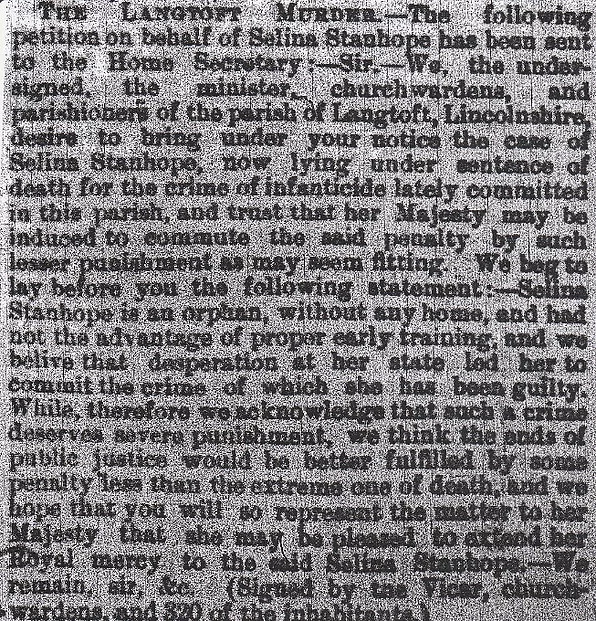Kesteven consists of the towns of- Bourne, Grantham, Lincoln, Sleaford and Stamford, plus the surrounding villages.
1/ Somerby Hill Fatal Accident, near Grantham, May 25th, 1907
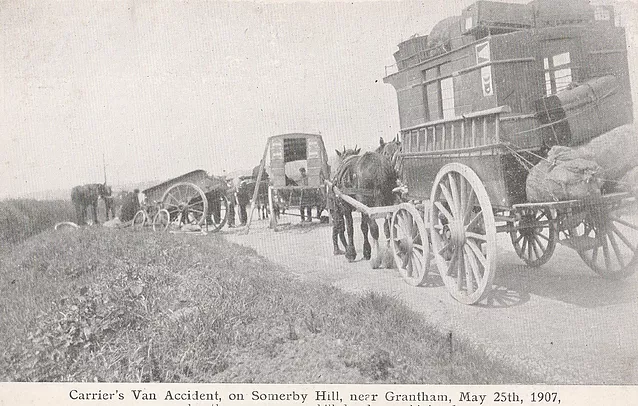
The paper describes four people being killed, but the postcard above says it was three and several injured. It doesn’t look that serious on the face of it. It also says that it was Mr Wilkinson of Lenton who was on his way to Grantham market with goods and a dozen passengers on his waggon when the horse began to kick out. Mr Wilkinson tried to calm the beast by the head but he missed and the horse bolted down Somerby Hill and collided with a two-horse waggon. A woman named Miss Florence Piggins aged forty-seven, jumped off but landed on her head on the road and was killed on the spot. A man named George Bradford aged forty-four tried to stop the horse, but he was run down and had both legs were broken. He unfortunately died later on at Grantham Hospital. The other two deaths were 67-year-old Mrs Isaacs from Ropsley who died on her way to the hospital and Mrs Ely of Great Humby who received spinal injuries, which proved too severe as she succumbed about three hours after the crash.
2/ Fossdyke Canal (Lincoln) November 1895 (Child Murder)
A domestic servant by the name of Hannah Wright was sentenced to death at Lincoln for the murder of her illegitimate two-year-old boy, by drowning it in Fossdyke Canal (Fossdyke Navigation runs off Brayford Pool in Lincoln). She had told her sister that the father of the infant didn’t even know it existed. She went down to the canal and manually held it underwater until life was expired. When questioned about the murder, she readily admitted to killing him.
3/ Dyke Death, near Bourne August 1887
Arthur Albert Kettle aged fourteen was driving a horse and cart laden with oats and was on the way to his master’s farm. Despite being not told to do so, he rode on the shaft and he fell off and then the cart ran over his head. Kettle died within five minutes of the accident. The verdict accordingly was “Accidental Death”.
4/ Great Gonerby Churchyard Suicide (Grantham) September 1865
Mrs Sarah Farnsworth aged fifty-two, of Westgate in Grantham, left home one Tuesday and disappeared for a couple of days, then her body was found in Great Gonerby churchyard. Her daughter Elizabeth, said that her mother was always short of cash ever since she left her shop-keeping job about six years ago. A friend of her’s, Jane Ward, said that she asked her to lend her a couple of pence, which she did, she then scuttled off in a hurry. Then on Friday, a boy named Ashbourn told the local policeman John Preston, that there was the dead body of a woman in the churchyard. Upon inspection, it was found to be Sarah who was sat upright with her back leaned on a gravestone, with a prayer-book next to her. Her pockets had two empty bottles in them, probably laudanum bottles and the post-mortem revealed she had died from narcotic poisoning. “Suicide whilst of unsound mind”.
5/ Clayton & Shuttleworth, Lincoln, (Shocking Death) September 1906
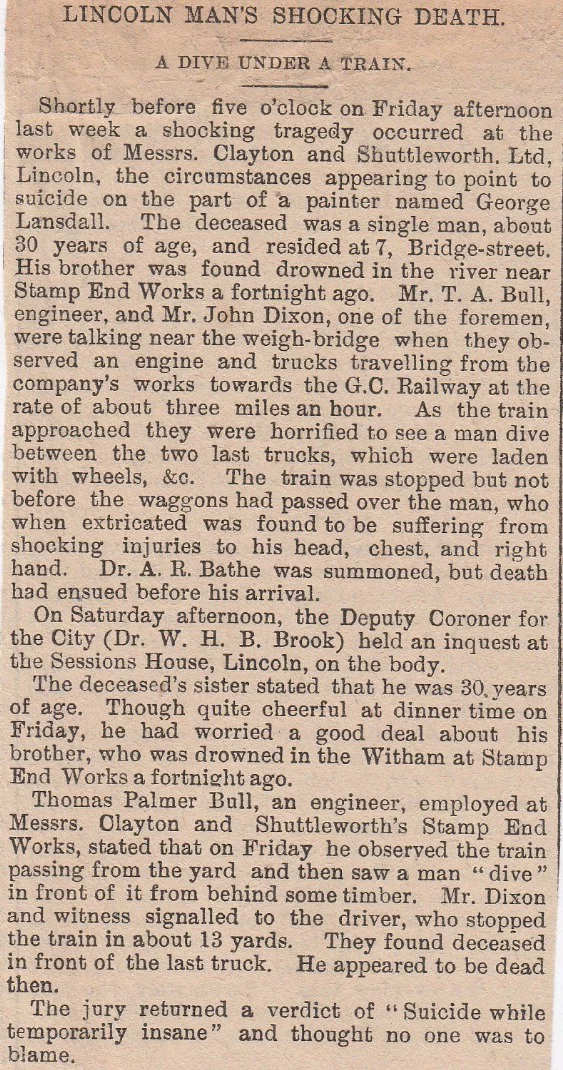
6/ Stamford, (Horrific Death) April 1904
Seventeen-year-old James Caunt was admitted to hospital with terrible internal injuries, sadly three hours later he died from them. Three workmen who were mucking about with a force pump said that Caunt joined in the japes and put the nozzle between his legs. His innards began to swell and he was in great agony when admitted to hospital. He managed to tell a nurse that two men had held him down and the other bloke had shoved it up him. (Presumably his bottom!) He died from his gut rupturing and peritonitis setting in. The men, James Thorold, George Burrows and Charles Baker were found guilty of manslaughter and of”feloniously killing him”. What a way to die, poor bugger!
7/ Old Ship Inn, Pointon, August 1906 (This pub is still there! Murder/or Suicide?)
Mrs Hind, the wife of the landlord of the Old Ship Inn at Pointon, was discovered lying in a heap on the living-room floor with three bullet wounds to the body. A shot had ignited her clothes and the resultant burns, caused her to be rushed to the hospital. She died a month later of her burns.
8/ Sleaford Railway Station, (Fatality) October 1894
William Trolley aged forty, a plate-layer who worked for the Great Eastern Railway Co., was run over by a goods train at Sleaford. He was killed about twenty yards from his house, having the top of his head severed off, causing instant death. He leaves a widow and six children.
9/ Belton Park Suicide, December 1915
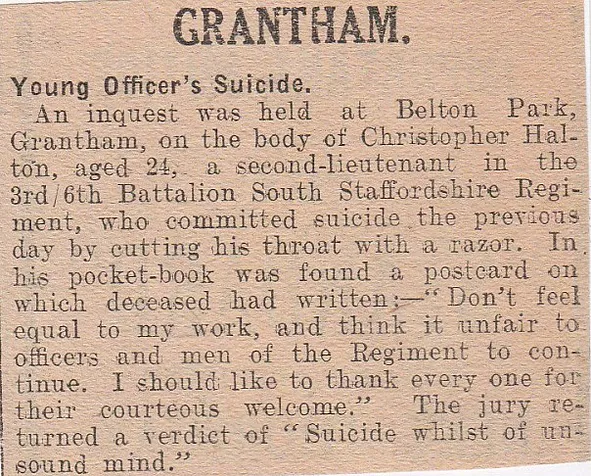
10/ Belton Park Death, July 1869
Volunteers from adjoining counties met at Belton Park for inspection by Colonel Wombwell, with the Robin Hoods of Nottingham excelling in the exercise. In the searing heat of July 1869, they marched to Belton Park, which is a couple of miles from the railway station. The bandmaster of the March Rifle Corps dropped down dead from heat exhaustion and it is also thought that another death has occurred at the same time. Around fifty men were treated for heat exhaustion and whisked off to hospitals. There were several thousand men in the area performing these manoeuvres.(Anyone know any more?)
11/ Lincoln Lunatic Asylum Suicide, December 1864
Sixty-year-old Samuel Baker, who was a patient at the Lincoln Lunatic Asylum, killed himself by hanging. He was clearly in the right establishment because he believed that every meal he ate cost him a £1000, therefore he hardly ate a morsel while there. He tied one end of his handkerchief to the doorknob and other around his neck, then sank down to the ground slowly strangling himself.
12/ The Strugglers Inn Suicide, Lincoln, October 1883
This pub is right next to the castle on Westgate and this is where crowds would gather to watch the public executions. I believe it to be the case that the condemned prisoners were allowed a pint in here before they were strung up. Is it true? Anyway, in October of 1883, Charles Lewis aged fifty-three, was discovered in a hayloft adjoining the Struggler’s pub, hanging from a beam. The brother of Lewis said he was a very depressed sort of person, unmarried and was addicted to drink. The man who found the body, William Brown, said he went up to the granary and saw him hanging by a rope. He was in the pub the previous night enjoying a jar or two and didn’t seem despondent in any way.
One thing that could have led to his suicide was the fact that he had nowhere to live since their mother died a few months ago. When found by P.C. Calvert he had no money on him and his feet were on the ground, with one hand was grasping the rope. The verdict was the same as always in these cases, with “Suicide during temporary insanity”.
13/ Boothby Pagnell Fatality, September 1909
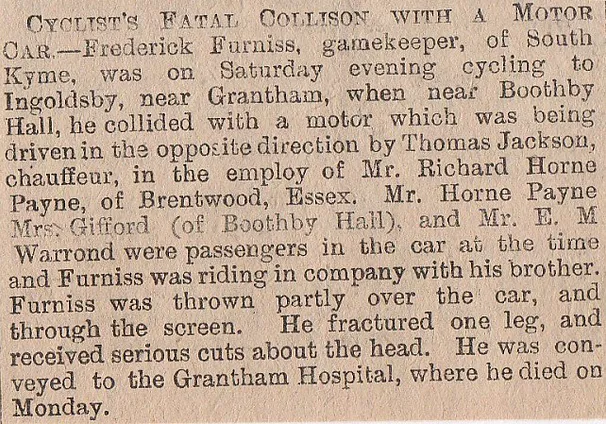
14/ Burton (Lincoln) November 1888 (Decomposed Corpse Found)
An atrocious discovery was made at Burton Fen when a couple of men named Gray were going through the cemetery plantation in Burton Fen, when they stumbled upon the body of a man in the water. He was badly decomposed, wearing a black jacket and a pair of cords and was about sixty odd. He had no front teeth and had a full beard. The corpse was identified as that of William Meadows, who worked for a builders in Lincoln, who went missing in early July and hadn’t been seen until now. His wife was extremely worried as to his whereabouts and thought he had gone to America to see his daughter.
15/ Stamford Suicide, March 1888
Thomas Williams aged fifty-seven killed himself by jumping off the iron bridge over the River Welland into the water. A passer-by named Taylor heard the splash, but could not help the man as he himself couldn’t swim. He went to get help elsewhere and police dragged the river, the body was finally recovered. Williams suffered from severe rheumatism and this preyed on his mind as the work had dried up about three years ago.
16/ Sleaford Railway Station Death, March 1883
Robert Nichol, a signalman’s labourer in his seventies from Boston, was knocked down by a train at Sleaford Railway Station. He worked on the Great Northern Railway and was working on the new station at Sleaford. While shifting to avoid a locomotive he stepped right in front of a ballast train. His legs were nearly severed in the accident and he was carried to the waiting-room, to await medical attention. When on his way to the hospital at Boston, he dictated the terms of his will. When he arrived both legs were amputated and it was found he had serious head injuries as well.
17/ Lincoln, (Suicide by Mirror) August 1889

18/ Deeping St Nicholas, (Traction Engine Death) October 1909
A shocking accident befell poor Mary Mulligan as she came back home from Roman Catholic funeral with her brother, who is a Catholic priest, as they were cycling. It was a bit windy and she was riding one-handed, with the other holding on to her hat when they saw a traction engine coming up. While in the process of passing the huge vehicle she skidded and her arm fell under the machine. As she screamed in pain, her head and body were dragged under as well, causing her to killed on the spot. Sadly Miss Mulligan would have gone to a convent near Manchester to finish her education.
19/ Bourne Workhouse Suicide, February 1897
An inmate of the Union Workhouse at Bourne, Thomas Smith, despite being well into his eighties, decided that suicide was the best option for him, so he slit his throat with a razor in the yard adjoining the day room.
20/ Traveller’s Rest Inn Death, Lincoln, October 1880
As far as I know, this pub is still there but used for student accommodation nowadays. Anyone staying there, hold a seance and see if you can muster up the spirit of Mrs Mary Butler, a 48-year-old widow who was landlady of the Traveller’s Rest. She went to bed at ten p.m. one Sunday night and during the night her two daughters heard a noise. They called out to their Mum but she never answered and on closer inspection, she was found to be deceased.
21/ Lincoln Railway Station Suicide, August 1854
As the train stopped at Lincoln station at 3-30 p.m., as a porter opened the door to the first-class carriage they discovered the corpse of a gentleman with a bottle of poison next to him. His identity at the time was unknown.
22/ Temple Bruer Child Murder, February 1879
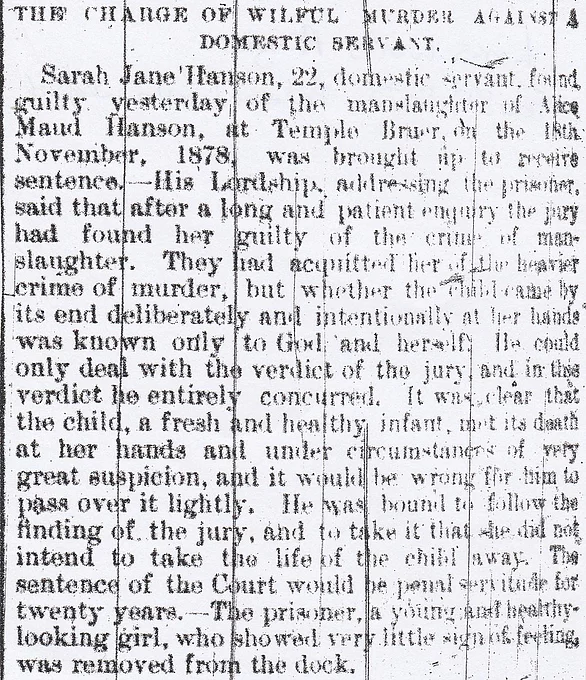
23/ Ruskington Fatal Accident, (Sleaford) November 1917
This rang a bell as soon as I heard the name. I remember seeing Richard Madeley on “This Morning” getting terribly excited by the tales from locals who rang into the show, saying that they had seen a face in their car windows while driving near Ruskington. They nicknamed it “The Ruskington Horror” and no feasible explanation was ever put forward, as to the cause of this highway haunting. I doubt it was this lady though. While crossing the railway line at Ruskington, Mrs Pattinson the wife of Alderman Robert Pattinson, a well-known figure locally, was run down by a passing train and killed instantly.
24/ North Hykeham Filicide, September 1901
Mary Jane Roe of North Hykeham, grabbed hold of her three-year-old son and cut his throat with a kitchen knife. Then, in “Amityville” style, she calmly moved about the house and walked upstairs and slit the throats of her eight-year-old and her five-year-old, who were asleep in bed. The youngest, Alfred, was killed at the scene, but the other two pulled through. Roe was arrested and is in custody. (What happened to her?)
25/ Brayford Pool Body (Lincoln) October 1884
The body of a male child was fished out of Brayford Pool when discovered by George Barton, the water bailiff. He was in a boat on the Pool when he spotted, what he thought was a package, floating on top. He managed to grasp hold of it and found to his horror it was the body of a child wrapped in a newspaper. The body was taken to the mortuary and police are looking into the matter.
26/ St Leonard’s Street, Stamford, (Tragedy at a Well) December 1900

27/ Heckington Murder, March 1833
William Burbank was a well-known member of the village society at Heckington. He had a good day at work, making a few bob on the way. He went to celebrate with a drink in a beer-house at three p.m. and got talking to a group of men who were in there propping up the bar. When he mentioned he’d made a few quid, their ears pricked up and when he left an hour later, to head off to Boston, he was followed by William Taylor who bludgeoned the old fella to death. He smashed in his jaw and broke other bones in his body, giving him a really good kicking, then robbing him of all his cash. His mutilated body was found early the next morning. William Taylor was arrested and later convicted of the murder of Burbank. He was hanged at Lincoln on March 18th, 1833.
28/ Bourne Drowning, February 1887
An inquest was held into the death of Stephen Russell, a shoemaker, who was discovered lying face down in approximately two feet of water in a stream that ran past his back door, wearing only his socks and a shirt. The landlady reports seeing him in bed earlier on and said he had been receiving medical treatment lately. He was alive when fished out but died after less than a minute. The verdict was, that he had died from shock and drowning, but the mystery remained as to what he was doing there.
29/ Nottingham and Grantham Canal Body, July 1888
William Bond Newcombe, a forty-year-old groom, was discovered floating in the Nottingham and Grantham Canal. His father identified the body and stated that he was a single man and lived in Swinegate. He was found by William Brassley of Harlaxton, who saw the man on the surface but went to tell the police, rather than fish him out.
30/ King Street/Sincil Bank, (Drowning Mystery) December 1915

31/ Monks Abbey Crossing Suicide, Lincoln, February 1892
As the Cleethorpes train approached the station at Lincoln, due in at 9-17, it went over the crossing at Monk’s Abbey. The stoker saw a man sitting on a gate, then he suddenly ran to the tracks and put his head down on them and let the train run over him. They found the mutilated remains later on, with the head virtually non-existent. The remnants of the unknown man had brown beard and moustache, around thirty-ish and about five feet seven tall.
32/ Barkston Junction Manslaughters, (Grantham) March 1874
John Whittle, an engine driver, was charged with the manslaughter of Henry Crawford and Arthur Casburn. This was as a result of the fatal collision at Barkstone Junction, approximately three miles from Grantham on January 10th in a dense fog. He was found not guilty of any neglect that would render him open to a manslaughter charge and it was deemed to be an innocent mistake. Whittle was discharged.
33/ Ewerby Lightning Fatality, (Sleaford) May 1891
Whilst working in a field at Ewerby near Sleaford one Wednesday afternoon, a labourer named Bee was struck by lightning and was instantly killed. Two companions escaped unhurt.
34/ Helpringham (Sleaford) June 1895 (Not very often you see this jury verdict!)
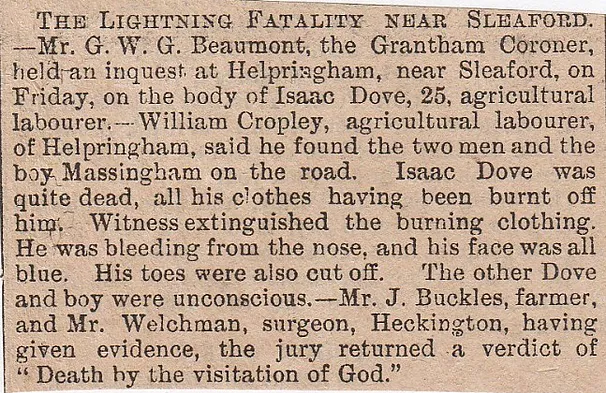
35/ Morton near Bourne (Burned to Death) January 1909
A horrific burning fatality occurred at Morton near Bourne when 14-year-old Jessie Beatrice Frone was trying to look after a five-year-old child and adjust her hat in windy conditions, then disaster struck. She was trying to adjust her hat and put the lantern, which had broken glass in it, between her arms. The flame, fanned by the wind, caught her clothes and next thing she knew she was on fire. Poor Jessie died from the third degree burns to her skin.
36/ Durham Ox Crossing Fatality, Lincoln, May 1885
George Willey’s wife, of No.24, Montagu Street, was standing at the Durham Ox Crossing chatting with her husband and two other blokes. The gates closed, in order that a pair of trains could pass through. This little party were right where the tracks fork in different directions, and to top it all Mrs Willey’s dog ran off and she made an effort to save it. She was struck and landed a couple of yards away, on the line, then the rest of the train ran over her virtually cutting her in two. “Accidental Death”.
37/ Welham Street, Grantham /River Witham (Baby’s Body) September 1887
A man by the name of Rose was walking along the River Witham bank, near the bottom of Welham Street, when he noticed something in the water. It was a parcel wrapped in brown paper and Rose’s dog managed to fish it out. When unwrapping the package he finally found the body of a baby boy. The post-mortem revealed that it was fully formed, had never breathed but it had a bruise on its head. The Coroner suggested a verdict of “Still-born” be returned, which was duly done.
38/ Lincoln Castle Executions (1722/1747)
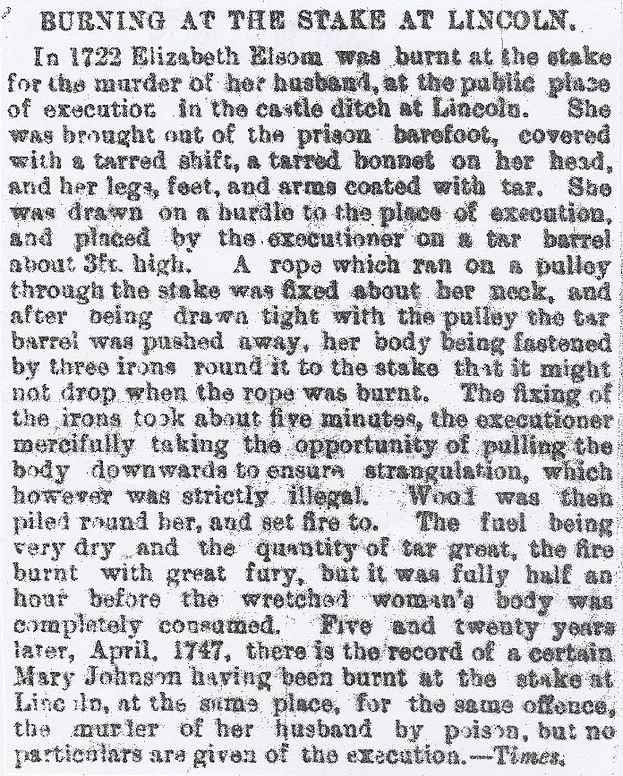
39/ Thurlby (near Bourne) August 1890 (Double Murder /Suicide)
A man named Charles Holliday lived with Hannah Hall in one of the cottages less than a hundred yards from the railway station, along with 7-year-old Charles Hall and their six-month-old, Harriet Holliday. He went off on Saturday night and when he returned on Monday morning all the curtains were drawn with no sign of anyone about. The neighbours were worried, so a policeman went to look for Holliday and found him and asked him to come back home to find out if all was OK. The door was forced open and the first thing they saw was Hannah Hall, hanging from a beam with an upturned chair nearby. Even more horrendous a sight was to greet them upstairs, when they found the two children laid in bed with their throats slit. The little boys head was nearly detached from the body, with the baby also badly mutilated. It is believed that thirty-seven-year-old Hannah Hall was an alcoholic.
40/ Grantham Area (Man Decapitated) March 1899
A verdict of accidental death was returned yesterday in the case of a man who was found decapitated on the Great Northern line near Grantham. From inquiries made at Newcastle, it is believed that he was John Hemingway Woodhead, lately carrying on business there as a builder and contractor.
41/ Tallington Crossing Decapitation, November 1883
A fatal accident occurred to a Mr Porteous, a tradesman from Peterborough in Cambridgeshire. He was crossing the railway line at Tallington when he was run over by an engine and decapitated. He was an owner of a lot of property in the Peterborough area.
42/ Lincoln Fair Fatality, May 1888
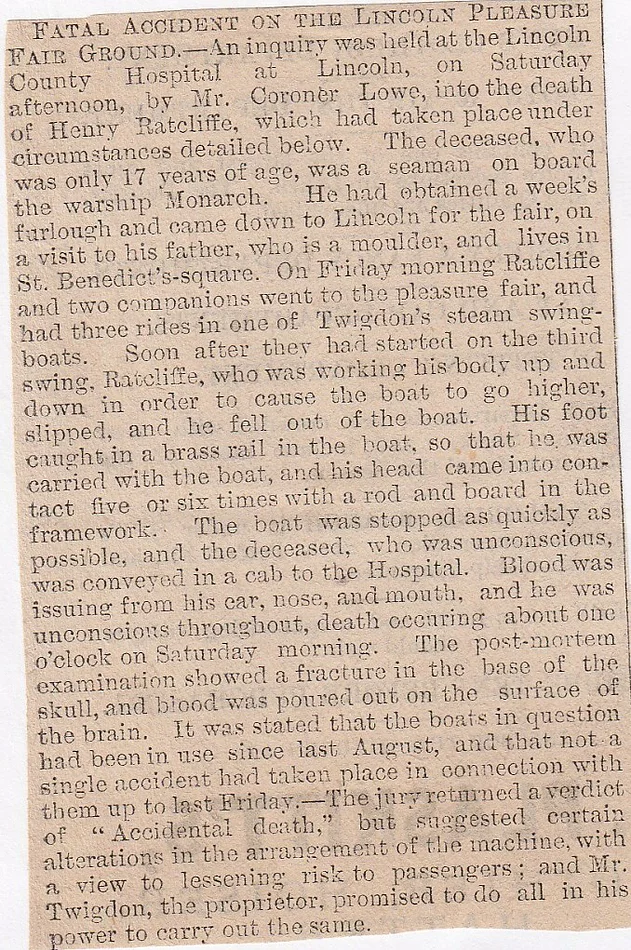
43/ Canwick, March 1857 (Skeletons Discovered)
While some workmen were excavating earth on Major Sibthorp M.P.’s estate at Canwick, they found a couple of skeletons about a foot and a half below the surface. One is adult and the other is of a child, approximately three-years-old. The adult was in the foetal position and close to the bodies was a razor and a small dagger, both rusted up. The local villagers were scared to go near the place where they were dug up, saying that it filled them with dread and despite not knowing that there was a pair of skeletons under the ground. It looks to be a case of double murder. (What became of the bodies?/Was it murder?)
44/ Leadenham (Sleaford) (Hayfork Fatality) September 1887
Arthur Theaker aged thirteen, died from injuries received while working for Mr Howard of Leadenham. He fell from a ladder straight on to a hay fork, with the prongs having penetrated his head. The doctor was called at 5-30 p.m. and by this time he was unconscious. The skull was fractured and the fork prong had entered the brain. He lingered until the next day when he finally succumbed to his horrific injuries. It was deemed “Accidental Death.”
45/ Fighting Cocks Manslaughter, Corby Glen, (Stamford/Grantham) November 1886 (The pub is still there!)
George Parker met with his death outside the Fighting Cocks public house in Corby Glen. He got into an argument with a bloke named Edward Bullock on the 10th November, all about politics and then the inevitable fight took place. The landlord threw them both out, but they carried on outside and Bullock punched Parker in the face, then he smacked his head on the pavement. He suffered from a fractured skull and died the following day from compression of the brain and Bullock, the 24-year-old shoemaker was charged with manslaughter.
46/ Lincoln Double Murder, June 1885
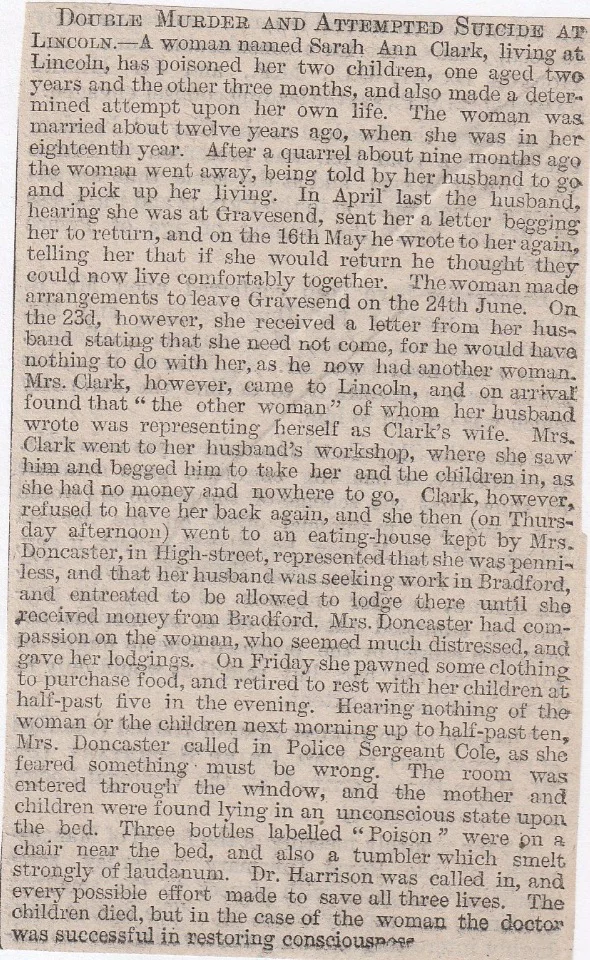
47/ Grimsthorpe Castle (near Bourne) (Car Crash) May 1902
A fatal car accident took place near to Grimsthorpe Castle. The chauffeur to Lord Willoughby de Eresby was driving his master’s car with three adults and a child as passengers when the car spun out of control when going down a hill. The passengers were thrown free, but the chauffeur was killed at the scene. A coachman received terrible injuries and is not likely to pull through. All others were OK, with the child was luckiest of all, being flung over a hedge and sustaining minor cuts.
48/ Stamford Drowning, August 1882
A lad named James Roberts living in St Leonard’s Street, Stamford, was drowned whilst bathing in the river near Studd’s Mills on Wednesday afternoon.
49/ Lincoln Lunatic Asylum, (Set Himself Alight) May 1833
A patient at the Lincoln Lunatic Asylum, Charles Stephenson, had a habit of self-immolating and this came to a head when smoke was seen to come from a window in his room. He somehow managed to set light to his clothes. He was in the infirmary for four or five days, in terrible agony until he passed away. He was sixty-three and had been in the asylum for a number of months.
50/ Dunston Fatality, April 1909
A car in which Lord Westmorland and other Blankney Hall guests were driving, overtook a horse and cart being driven by a boy. The horse reared up and knocked the young lad down, then ran over him. The motor-car conveyed the boy to Lincoln Hospital but he died on the way. He was later identified as having the name Asher and was only fifteen years of age.
51/ South Stoke Suicide, near Grantham, August 1892
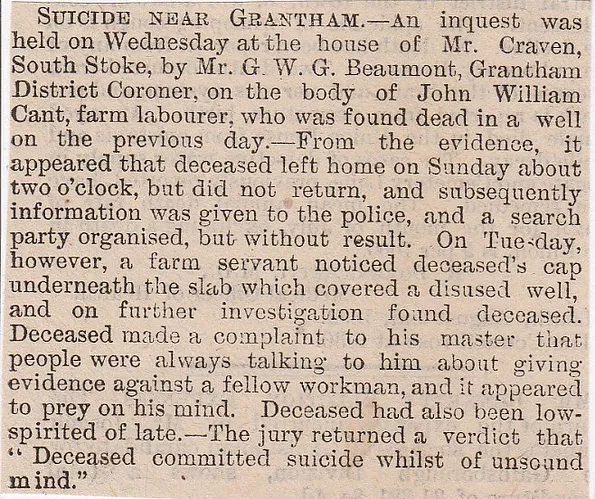
52/ Stamford Railway Remains, April 1909
The mutilated remains of a middle-aged man was discovered on the Midland Railway near Stamford. The four p.m.train from Peterborough found traces of blood on the engine, so this is thought to be the train that struck the stranger. When he was discovered he had both legs missing as they had more than likely been sliced off by the train.
53/ Bourne Manslaughter, July 1891
Two men named Garfoot and Fairchild who were both employed on the Great Northern and Midland line at Bourne, were both lodging in the same house, when an argument erupted, with Garfoot accusing Fairchild of taking too much interest in his missus. Garfoot beat the hell out of Fairchild and gave him a fractured skull and had a leg broken, along with a shattered ankle, as a result of the altercation between the two of them. Fairchild lay in hospital in a critical condition and Garfoot was arrested.
54/ Stoke Grange near Grantham July 1887
An awful accident occurred at Stoke Grange, about eight miles from Grantham, when Frederick Minta, a farmer, was trying to get a tree trunk from out of the River Witham. A team of horses dragged the giant hunk of timber onto the bank, when Minta got snagged up in the chains and the huge tree was dragged over his body. He screamed at the others to release the tree, but they levered it up so he could be released and he died about ten minutes after being freed.
55/ Reepham, (Awful Death) March 1883
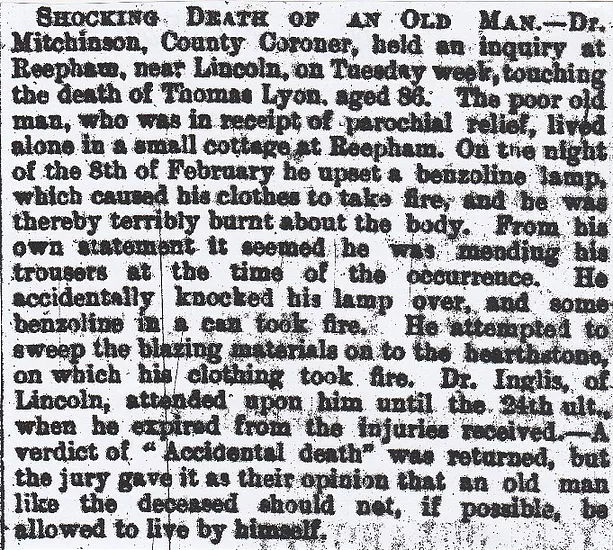
56/ Edenham Double Suicide, near Bourne, July 1907
Claude Deering Dean and Emily Lockwood struck up a close relationship while he was Long Eaton. Not unusual you might say, but the problem was that he had a wife and kids in Birmingham. They became infatuated with each other and passed off as husband and wife. They decided on a suicide pact together, by both taking a swig of oxalic acid, then jumping into the river at Edenham. The law states that if attempt suicide together and one of you survives, the other one can be tried for murder. This is just what happened and Deering was sentenced to death for his part in all this, but he was reprieved at the last minute and given the sentence of penal servitude (hard labour), for life. He was Richard Deering in some newspapers!
57/ Stanley PlaceMurder, Lincoln, April 1891
Twenty-four-year-old Arthur Spencer, a butcher by trade, was seeing a 30-year-old widow with four kids by the name of Mary Garner. He asked her to marry him, but she wasn’t interested and kept on refusing his offers. He laid it on the line one evening and said that if she didn’t marry him, he would kill her, then commit suicide. Mary laughed it off but he turned up at her home in Stanley Place one night and shot her in the chest. Mary managed to get to the neighbour’s house but she died within the hour. Spencer was found on the floor of her house with a gunshot wound to the mouth. He survived and was later on, in July 1891 sentenced to death for her callous murder.
58/ Woolsthorpe-by-Colsterworth, August 1884 (Double Child Murder)
Sarah Ann Rippin of Woolsthorpe-by-Colsterworth near Grantham was charged with the murder of her two children. Annie Elizabeth Rippin, thirteen months and John Thomas Rippin aged three years were the victims. She took them to the pond at Colsterworth and drowned them, then this story was repeated to her neighbour who then informed the local police. The policeman went to the home of Sarah Rippin and asked her where the children were. She pointed to the pond. They immediately dragged the pond and found the two, with their heads buried in the silt at the bottom of the pond. (What happened to her?)
59/ River Welland at Stamford, (Child Drowns) February 1895
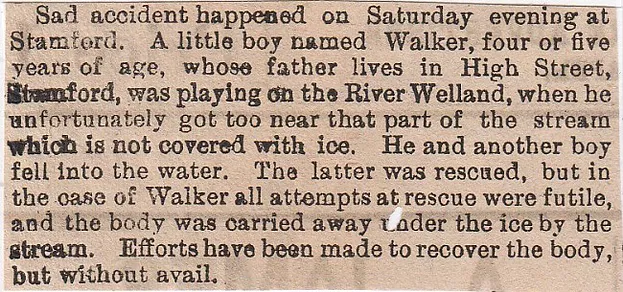
60/ Norton Disney Gamekeeper Murder, February 1877
Henry Walker, the gamekeeper on Viscount St Vincent’s estate at Norton Disney, was with a watcher named Wells in a woods about a mile from the village. They heard a gunshot coming from a plantation so they hurried in that direction. Two poachers came out of nowhere and threatened to blow their heads off if they came closer. They ignored them, but the two poachers ran off through the plantation and they eventually lost them. They caught up with them and this time when they were told not to come any nearer, they again ignored them, but this time the poacher shot him in the legs. Wells went to get help and Walker was taken back to his cottage. He was medically cared for but he died a few days later. Three men were arrested, but Wells couldn’t identify two of them, so the real killer was still out there somewhere. (Was anyone ever tried for Walker’s murder?)
61/ Helpringham (Sleaford) June 1895 (Lightning Fatality)
Two brothers by the name of Dove, along with another man named Massingham, were in the corn-fields labouring at Helpringham, when they were struck by lightning. Massingham and one Dove brother were badly injured, but sadly the other Dove brother died at the scene. Massingham is in a critical condition. (Did Massingham make it?)
62/ Skellingthorpe (Concealment of Birth), (Lincoln) July 1869
A 1fifteen-year-old domestic servant named Mary Ann Hollingsworth, was up in court on a charge of wilful murder of her female infant on May 2nd,1869 at Skellingthorpe. The judge said there was no case for murder and although she might have known her condition and attempted to conceal it, her child was delivered without her knowledge, with her having mistaken the symptoms. Even though he knew of the delivery afterwards and having not mentioned it, they could not find her guilty of concealing its birth.
63/ River Welland Drowning, Stamford, July 1888

64/ Uffington Newly-Wed Suicide, (Stamford) September 1865
A suicide in the village of Uffington near Stamford, has caused quite a buzz in the neighbourhood. Richard Barsby, a sixty-four-year-old labourer married a sixty-year-old widow, Elizabeth Kirby and while he went out to work she stayed at home and did the house-wife chores. Barsby comes home one evening and finds Elizabeth dead, with a glass next to her and some powdery residue at the bottom of it, probably laudanum. He found a letter with the wedding ring in, explaining that she was fed-up and wanted to die, despite being newly married.
65/ Timberland Suicide, September 1888
The postmaster at Timberland, Thomas Abbot, was found in a water-butt with the top half of his body immersed in the water. He had calmly put his hat and stick down then committed suicide by going head-first into the tub.
66/ Washingborough Shooting, May 1859
I doubt if you’ll see the headline “Harry Enfield Accidentally Shot”, but that was exactly what happened in this case. Henry Enfield was part of a group of poachers who were on their way to Washingborough, when the loaded gun in his pocket fell out and went off, sending the bullet straight into his head, nearly blowing off one side of his face. This was all seen by a passing train guard who was on the Boston/Lincoln train at the time. When he rolled into the station, he explained what he had spotted to a copper and they, in turn, went to Washingborough and took care of his corpse.
67/ Lincoln Workhouse Suicide, January 1883 (On Burton Road)
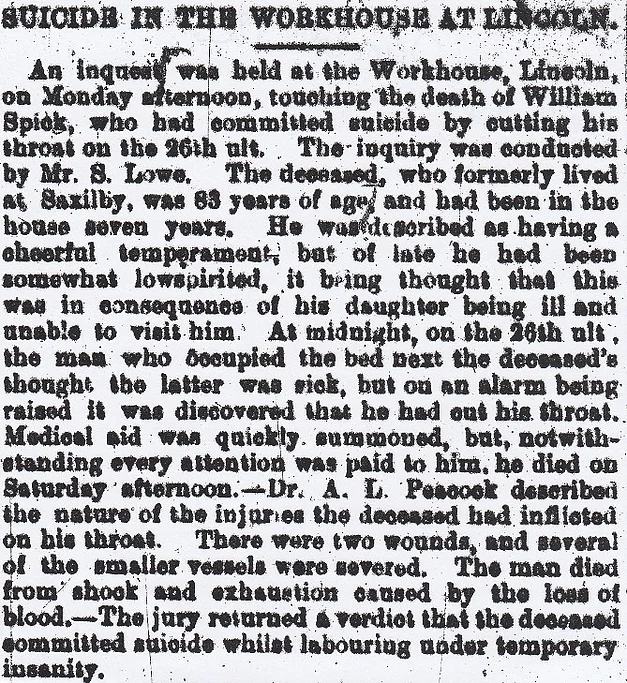
68/ Little Bytham Railway Station Fatality, September 1884
William Camm, a platelayer aged thirty-three was killed at Little Bytham Railway Station while working for the Great Northern Railway Company. Camm was with Charles Edinburgh, William Taylor and Robert Daft re-sleepering the siding and they had to move some trucks which were in the way. They had removed two and were moving the third, when the last one started to slide towards them and caught Edinburgh and Camm between the buffers, which neither saw or heard coming as an engine was blowing off steam at that exact time. Both men were whisked off to the hospital, where Camm died and Edinburgh escaped with a few minor cuts and bruises.
69/ Coleby/Coleby Lodge Fatal Accident, (Six miles south of Lincoln) December 1883
Joseph Goy was a forty-three-year-old labourer who worked for Mr Howard of Coleby Lodge near Lincoln. Goy and another man named Baker, were putting some sheeting on the top of the haystacks, which had been blown off in the night, back on, when Goy was blown by the gust of wind onto the hard frost-bitten earth. The distance was about fifteen feet and he landed on his head and dislocated his spinal column, therefore rendering him paralysed. At Lincoln County Hospital it was discovered that he had no use of his arms, legs or chest muscles, and from here on he got progressively worse and eventually died of his injuries.
70/ Stamford Child Murder? August 1867
Edwin Goldsborough aged thirty-six and Louisa Elston, alias Tomlin, were charged with the murder of Alfred Elston on the 16th March last. Both of them were inmates of the Thrapstone Workhouse in Northamptonshire and it was while they were here that someone heard the two of them planning to go off together and that she would take the child with her. When they arrived in Stamford, he told her that the child was a hindrance and she should get rid of it. Not long after this conversation, Louisa told a policeman that her child had fallen in the river. He was suspicious and they were taken to the police station. In the end, Goldsborough was let off and she too received a “Not Guilty” verdict of murdering her child.
71/ Mint Lane off Mint Street, Lincoln, (Suicide by Poisoning) June 1889

72/ Welton Cliff Suicide near Lincoln, February 1885
Edward Knowles was a sixty-seven-year-old farmer from Welton Cliff near Lincoln. His wife woke up one morning to find him missing from bed, but she thought he had gone out early. Time ticked on and she got worried as to his whereabouts when a search was made to look for him. He was discovered in a pond in one of the fields and it was clearly a case of suicide, not an accident.
73/ Fulbeck Hall Hunting Death, (between Sleaford and Newark) March 1868
The splendidly named General Mildmay Fane, Colonel of the 54th Regiment, died in a hunting accident near to his country seat of Fulbeck Hall. His horse stumbled and threw him off, where he landed head-first. When attended to, he was found to be already dead with his neck having been broken.
74/ Claypole Station Fatality, near Grantham, November 1866
A verdict of “accidental death” was the outcome of the inquest into the death of a little girl at Claypole Station near Grantham. Seven-year-old Ada Newton, the signalman of Claypole Station’s daughter, went to speak her father when the express train was due to thunder through the little station. The father’s job is to signal if the line is clear, to pass the station and he was getting ready when Ada crossed the line, where the entire train, carriages and all, trundled over her frail body. She was badly mutilated and death was obviously instantaneous in this case. (No doubt closed and abandoned?)
75/ Deeping St Nicholas (Lightning Fatalities) July 1866

76/ Branston, (Concealment of Birth) July 1860
Ann Nutt was up on a charge of wilful murder of her illegitimate child at Branston on the 16th April. She was acquitted of this and convicted of the lesser crime of concealment of birth. The housekeeper had already been in custody for three months, so the judge ordered that she serve another three months with hard labour, for what she had done.
77/ Eagle, (Religious Suicide) March 1888
Between Lincoln and Newark lies the village of Eagle and it was here that 72-year-old Mr Crosby decided that suicide was a good option for him. His wife got up and started to make breakfast but when she called him to come down, there was no reply. She went up and found him hanging by a piece of cord from the bedpost. She raised an alarm and he was cut down by neighbours. No reason could be assigned for his self-destruction, apart from his depressed state of late, as the uber-zealous religious fanatic had seemed less hopeful for the future, so he had killed himself. Religion was not the answer!
78/ Sleaford Railway Station Fatality, November 1883
Another death near the station at Sleaford. This one was labourer Thomas Gray, who was run down by an express train while crossing the line at the West signal-box, not far from Sleaford Station. The gates were locked, as the train was due, but it’s thought that Gray climbed over the fence and was then struck by the train. A G.N.R shunter shouted at him that the train was coming and he ran to the other side but unfortunately he never made it. The train driver said he blew the whistle, but Gray just ignored it and before he could stop he had collided with him, leaving the body badly mutilated. The landlady of the house he lodged at said that he was a little deaf. He had also been unemployed for three weeks but was still in good spirits. The remains were carried to the Nags Inn, with a foot severed off and one leg carried some distance by the train. Also, one of his hands was just hanging on and the head smashed to a pulp.
79/ Lincoln High Street, (Tram Death) August 1886

80/ Upper Bracebridge Train Death, (Lincoln) April 1880
A dreadful accident occurred at Upper Bracebridge near Lincoln, while eight-year-old Elizabeth Poole was playing on Bloxholme Road with her cousins, two lads named Darcy, when a locomotive attached to a threshing machine came past. The driver told the kids to stay away, but kids being kids the two boys jumped on the straw elevator section of the thresher. Elizabeth just carried on walking next to the apparatus, when she tumbled and fell underneath. The wheels had gone directly over her head, causing instant death.
81/ Nocton Heath Poisoning, February 1849 (Was he ever found?)
A strange tale of a servant girl who was allegedly poisoned by the father of her child. The nineteen-year-old Mary Ann Melton who worked for Mr Hills, a farmer, was struck down with some kind of illness which was so severe that a doctor was called for and she was found to be collapsing all the time. The doctor, Mr Snow, was told by the girl that her sweetheart, John Clark, who worked as a shepherd, had told her to take some powders mixed with milk so she would miscarry. It turned out to be arsenic and she died after lingering a while. Mr Hills, whom they both worked for, was asked by Clark if he could lend him £10. He gave the lad the money and he wasn’t seen again. This was while his girlfriend was doubled over in bed dying from the poison he gave her.
82/ Colsterworth, November 1878 (Murder Confession)
In Nottingham one evening, a drunken chap named William Allen, went up to a policeman and confessed to a murder that he supposedly committed a couple of days ago on a girl named Elizabeth Bennett in a field in Colsterworth near Grantham. The police officer took it seriously enough to lock him up in the cells, while the matter was investigated. (Did he kill her?)
83/ Scothern Suicide, April 1882

84/ Market Deeping (Stamford) (Child Catches Light) August 1904
In a field at Market Deeping, a little girl named Hilda Batty was burned to death in a horrendous accident. Her parents left her guarding some labourer’s clothes, who was a few yards away and the young lass couldn’t resist digging around in the pockets. A box of matches came out and she began to strike them, one by one, but a spark caught hold of her clothes and within seconds she was a ball of flames. She was rolled on the floor and the fire was put out, but she sustained third-degree burns in the process and consequently, Hilda died from the burns.
85/ Coleby (South of Lincoln) June 1829 (Skeletons Found)
Several human skeletons were found about twelve inches below the surface at Coleby near Lincoln. They were in a foetal position and were not laid out in a common burial way. Along with the bones, there were swords and daggers buried with them and were believed to be Roman in origin. (Where did these end up?)
86/ Grantham/Ponton Train Fatality, August 1883
The inquest took place on the body of Ada Woods, wife of labourer George Woods, who was killed on the G.N.R. line. It was revealed that she was near-sighted and a bit deaf, when taking George’s tea to a field he was working in she crossed the path which led from Grantham to Ponton. The London to Scotland express came hurtling through at the exact same time she was crossing the line and she was hit, head on. It was judged as an “Accidental Death” and her remains, which had both arms and a leg severed clean off. She suffered facial mutilation and her trunk was crushed as well. It was recommended that a bridge should be erected in this accident hot-spot, within a six-year period.
87/ Grantham Octogenarian Suicide, March 1890

88/ Tallington Train Fatality, (Between Market Deeping/Stamford) May 1856
This is the first of three rather sickening railway accidents to happen at this little village within a decade or so. It was around ten a.m. at Tallington Station and the engine was coming down the tracks, when the gatekeeper thought that the engine was going to hit the gates, he ran out to close them and as he did so, he couldn’t get out of the way of the train and it ran over him. He was killed on the spot and his body was moved to the Cavendish Arms pub to await the inquest.
89/ Near Tallington Station, (Train Fatality) August 1861
An employee of the Great Northern Railway, Charles Goodlord, was killed on the line between Tallington and Essendine. His job was to slow the trains down as they approached the place where the repair work was underway. Goodlord fell asleep on the job, right on the railway tracks and as the driver got closer, he blew the whistle but he never woke up and tons of metal went straight over him. He was killed on the spot.
90/ Near Tallington Station, (Railway Fatality) March 1867
A farmer named Baines was on the train was returning from a trip to Grantham where he had just bought a new threshing-machine. He was late for his train and was told that it was best if he stayed overnight and go back the next morning. He ignored this advice and clambered on a goods train that passed through his station, Tallington. When he got near, he leapt off the train and sustained serious injuries. He was taken to Peterborough Hospital but only lasted the night. The other sad portion of this story is that he left a wife and nine children.
91/ Howell near Heckington (Schizophrenic Suicide) November 1849
Howell is one of those places that consists of a handful of houses and a number of farm buildings and that’s about it. George Toynbee though, owned over 500 acres in this little parish, but committed suicide by taking a large dose of arsenic. He had been married six years and was only thirty-three himself, but he had been suffering from mental hallucinations and believed that hideous ghosts were constantly plaguing him. He also left four small children without a father. (Was is schizophrenia?)
92/ Billingborough (Sleaford) (Teenagers Death) July 1889

93/ Billingborough, (Death Day After Wife) November 1903
An elderly couple, the Dawsons, lived at Billingborough near Sleaford. Mrs Dawson went to Sleaford for a few days on a visit to relatives, when she became extremely ill and died. The body was brought back to her home for burial at Billingborough. To eighty-year-old Mr Dawson, it was a shock to the system and when he observed the coffin with his wife’s body in it, he died the very next day. The two of them were buried together. (Are they in Billingborough churchyard?)
94/ Lincoln Wife Murder, January 1842
At the Lincoln Assizes, Francis Jeffreys, a 61-year-old farmer was tried for the murder of his wife. The only witness examined was his nephew and when he gave his evidence there was no doubt the old git had done his missus in. The Judge said that his uncle was clearly insane and had been like this for a long time. He was acquitted on the grounds of insanity. (Did he end up in Lincoln Lunatic Asylum?)
95/ Lincoln Station? August 1846 (Cannon Explodes)
The opening of the new Nottingham and Lincoln Railway saw a tradition of firing a cannon whenever a train departed or arrived at the station. In charge of firing the cannon was seventy-year-old Paul Harding, an ex-artilleryman, but now a pensioner. The Nottingham train rolled in and he fired the cannon when it suddenly burst and his shattered his right leg. In hospital they deemed it necessary to amputate the limb and now hopes of his recovery are slim. (Did he make it?)
96/ South Carlton, July 1864 (Suicide buried in Cemetery?)

97/ Lincoln Arboretum Drowning, September 1887
A sad case of drowning occurred at one of the ornamental pieces of water in the Arboretum at Lincoln. The victim was two-year-old Richard Downing West, who lived at Broadgate with his parents. His six-year-old sister was left to look after him while they were in the Arboretum and he fell into the lake whilst playing nearby. The keeper, Mr Hodson, was called over and pulled the little fella out but unfortunately, he was already expired by the time a doctor got there.
98/ Pyewipe Junction Fatality (Lincoln) November 1886
A wheel examiner named Metheringham was following his duties at work at the Pyewipe Junction near Lincoln, when he was run over by a passing express train. He was decapitated and had other horrific injuries. Metheringham had worked for the G.N.R. company for over a decade. The verdict was “Accidentally Killed.”
99/ Spittlegate Human Remains, Grantham, January 1885
Some workmen were digging the foundations for a new store at Messrs Hornaby’s Works in Spittlegate when they stumbled across a stone coffin and close by were two human skulls plus other remains. The coffin was believed to date from the 13th Century, plus it had intricate sculpture work on it and a niche had been carved for the head to rest in. The bones were gathered up and when pieced together they formed the skeletons of three males. The site where they were discovered was once a leper hospital, which was in existence around 1270 in the Spittlegate area of town. Huge crowds visited the site.
February 1885
The bones that were excavated at the Spittlegate site in Grantham were re-interred exactly where they were discovered. The stone coffin was six and a half feet long and was carved from sandstone. It weighed sixteen hundredweight. (About eight hundred kilos)
100/ Spotted Cow Inn Fatality, Grantham, July 1889
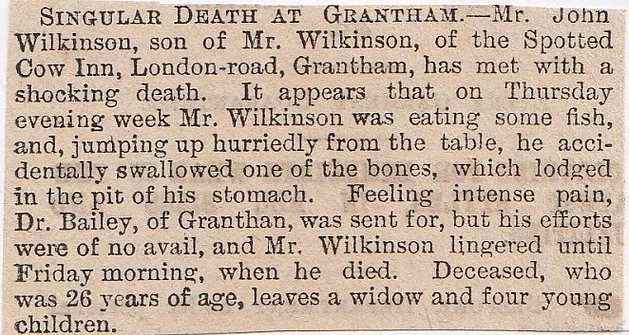
Lincoln Drownings 1884
101/ January
Hannah Alsford aged fifty, of 8, Napoleon Place in Lincoln, killed herself by drowning in the Sincil Dyke. She was up all night, then went downstairs at about 5-30 a.m. Her husband James Alsford went down a bit later on but his wife was nowhere to be seen. He went around to her friends and relatives to see if he could find her. A skirt was seen in the ditch opposite the house and this was then dragged. Word came through while this was going on, that a woman’s body was found about a mile and a half away in Washingborough and it was proved to be that of Hannah.
102/ February
The body of Mary Hutchinson aged seventy-five who lived with her husband at Gadsby Court, High Street, St Botolph’s was discovered in Great Gowt’s Drain. She went out shopping one evening but never came back. Her husband John believed that she had stayed with her niece for the night so wasn’t really that worried. The next morning she was found floating in the Great Gowt’s Drain, just below Gowt’s Bridge. It was thought that she got lost and slipped and fell into the drain. “Accidentally Drowned”.
103/ June
James Connor was found drowned in the River Witham. John Robert Green went fishing near the swing bridge when his fishing hook snagged on something and when pulled up, it was attached to Connor’s clothing. The lad screamed out and a passing policeman went to his aid. Connor had just done a stint in prison just one month for thieving and also pertinent to his state of his mind. The lodger who lived with him saw him near the river, drunk as a skunk.
104/ Corby Glen Murder, August 1848
John Parker was up on a charge of murdering his own father. He was found dead from a gunshot wound in his house and the main culprit, was his son. The jury eventually came to the conclusion that Parker was “Not Guilty” of the crime so he was discharged. The local population of Corby Glen was not satisfied with the verdict and they probed deeper into the murder and obtained some vital evidence. It turned out that his father and he had a massive row and the wife of the deceased (Mother?/Step-Mother?) heard the gun fired, but didn’t do a thing. Fortunately, neighbours heard the commotion and found the father dead on the floor. He kept on telling them it was an accident and when questioned about what happened, he kept on contradicting his own story. (Was he found Guilty?).
105/ Uffington (Stamford) November 1906
A fourteen-year-old lad Medwell, was busy cleaning knives at Aldwinckle’s Farm in Uffington, when suddenly the door was flung open and this knocked a loaded gun over, which then discharged the contents into the lad’s head and shoulder part of his body, killing him instantly.
106/ Ropsley near Grantham, (Accidental Death) October 1897
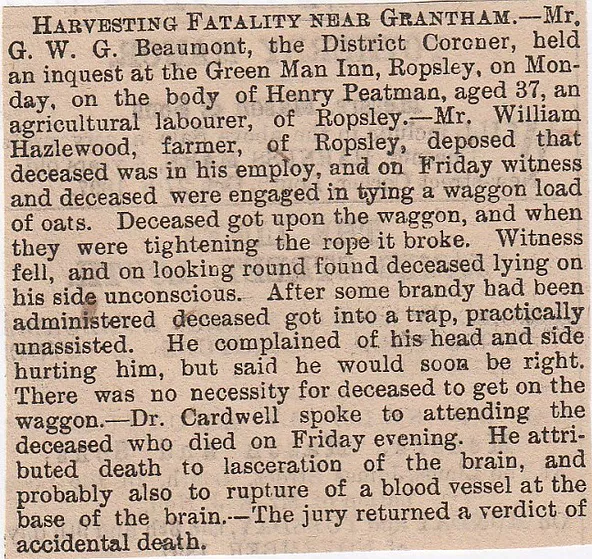
107/ Norman Street, Lincoln, (Impaled on Railings) February 1888
Thirteen-year-old Joseph Burton from Gresham Street was cleaning a second storey window at C.C.Smith’s, photographers, at No 1 Norman Street, when he fell and was impaled on the railings below. He was rushed to Lincoln County Hospital where died after a few days. The iron railing had impaled the lad’s neck and this caused the paralysis of his entire left side.
108/ Great Gonerby Vicar Suicide, September 1860
The Reverend W.C.Inman of Great Gonerby, killed himself due to congregation numbers at his church were continuing to decline.
109/ Great Gonerby Murder/Suicide, near Grantham, October 1846
An extraordinary tale of murder and suicide and of impersonating a police officer as well. George Healey brought nineteen-year-old Mary Hill to his father’s house. She stayed a few days, then left, while he was out. He was infuriated and set out to hunt her down. He tracked her down to an aunt’s house in Fulbeck near Grantham. We’ll skip a few days of the story here and go straight to a police officer at Sleaford, who had just got word that a man had poisoned himself with laudanum in the Plough beer-house. The officer went to see the corpse and it was George Healey! When the police in Grantham were told of this they began to suspect that he had first murdered Mary Hill, then done himself in at Sleaford. What had happened, was that he was mad with Mary and went to a constables house in Great Gonerby, borrowed his truncheon and handcuffs and gone back to see Mary Hill under the guise of being a policeman. He got to the aunt’s house, went in and said she was going to arrest her for pinching some silverware. Basically, after this, he kidnapped her and kept her in a locked room, then took her down to the River Witham and had simply thrown her in. Then after this, he had gone to Sleaford and killed himself at the Plough. Phew! Either way, he killed her then himself.
110/ Lincoln Girl’s Suicide, June 1883
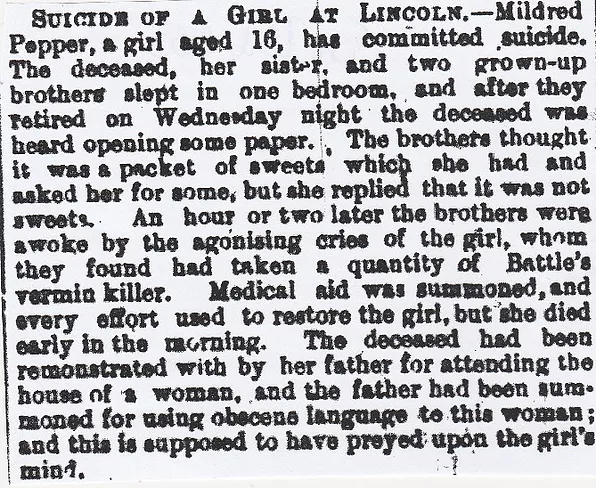
111/ Colsterworth near Grantham (Two Die in Fire) May 1850
A man named Thickett from Great Gonerby, who worked for Joseph Grummit of Bassingthorpe-cum-Westby to pare and burn sods at Colsterworth, made a hut of turf for his wife and kids so they could be near him, while he worked. Early one morning, the husband left for work and while the two kids were still in bed, his wife decided to wash some clothes. When she came back to the hut she saw it was in flames and she ran to the railway to get help from workmen. When they got there, it was way too late and the place was an inferno. The charred remains of ten-year-old Eliza Elizabeth Thickett and Mary Ann Thickett aged seven were taken out when the fire subsided.
112/ Lincoln outskirts, (Suicide) August 1889
Councillor Henry Pratt aged forty-eight, of the wine and spirit merchants Pratt and Son, was found lying dead in the driveway which led up to his house, about two miles from Lincoln city. Next to the body was a double-barrelled shotgun, which had been fired twice and also an umbrella, which was used by Pratt to fire the trigger. He leaves a wife and five children. (Where was this property of his?)
113/ Helpringham (Siblings Devoted to Other) January 1904
William Barley aged seventy-three, and his sister Marie Trolley aged seventy-one, had lived together for the past three decades and were totally devoted to each other, one simple reason was because they had no-one else. The next door neighbours hadn’t seen either of them for a while, so they looked in on them but got no answer. They shoved the door open and found Marie hanging in the parlour and William dead in bed. the police think that, on finding her brother dead in bed from natural causes, she couldn’t live without him, so she went and hung herself.
114/ Sincil Dyke Suicide, February 1864
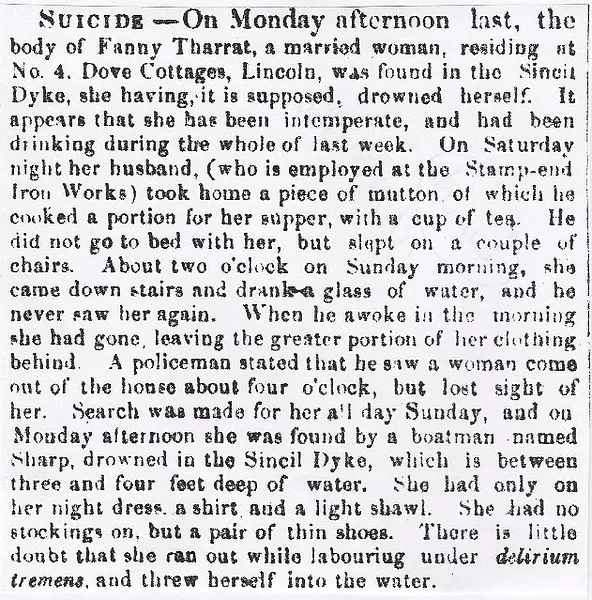
115/ Tallington/Deeping St James Murder/Suicide, December 1905
A young man named Shillaker murdered his mother, then shot his sister and then shot his girlfriend, Elsie Burgoyne at Tallington, a nearby village. Elsie’s mother wanted the two of them to get married and Shillaker went into Peterborough and bought a wedding ring and a revolver. He then shot his mother and sister in Deeping St James and shot Elsie in Tallington, after he had been for a stroll with her and got her to try on the ring. He shot her in the face, then put the muzzle in his mouth and pulled the trigger. The mother died at the scene and the two others are in a critical condition. (Did they make it?)
116/ Messrs Ruston, Proctor and Co. Lincoln,(Fatal Accident) January 1884
A striker named James Cooke aged twenty-four was accidentally killed at Messrs.Ruston, Proctor and Co’s Agricultural Works. His job was to crush coke, but the strap on the crushing machine flew off due to a chunk of clinker stopping the engine and Cooke was snagged in the machinery and was being rotated around several times at high speed. His right leg was torn off and his skull was crushed. It was judged to have been an accidental death, but it was all the fault of James Cooke as he should have known not to have taken hold of the strap while it was in motion.
117/ Dunston near Lincoln (Two Suffocate in Well) October 1908
Christopher Halkes, a builder, was inspecting a well at Dunston when he was overcome by the fumes and fell in. A lad of fourteen went to help him, but he too was overcome and he too fell into the toxic well. A labourer went down and he too was affected by the fumes, was quickly lifted out and was given mouth to mouth resuscitation. The well, on the grounds of the Vicarage, had been sealed up for approximately ten to twelve years. The teenage lad, Sydney Lupton and Halkes, died from suffocation by misadventure
118/ Dunston Fatal Accident, December 1884
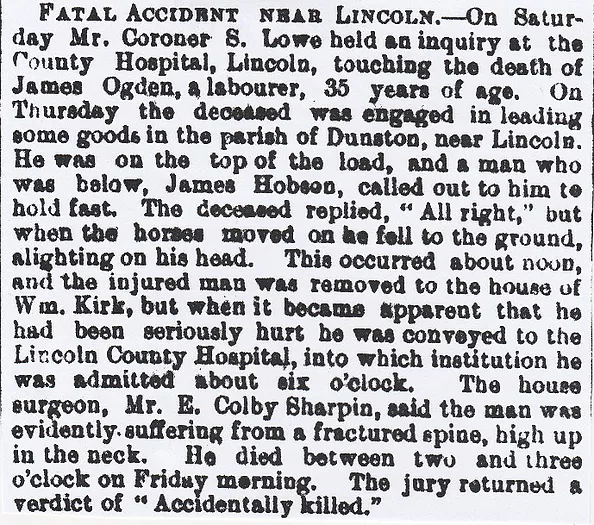
Lincoln Drownings
119/ River Witham October 1880
Ten-year-old Peter Chapman Graves, drowned in the river Witham when he accidentally slipped and fell in while he was playing on a boat near Foster and Co’s foundry, when leaping about on a boiler. The body was recovered about a hundred yards from where he slipped into the water.
120/ Sincil Dyke (Accident or Suicide?) November 1885
Charles Baker, a twenty-eight-year-old fitter was found drowned at the Sincil Dyke in Lincoln. It turns out that Baker and a man named John Scarfe went to the races together, then went on a pub-crawl on the night-time. Scarfe was paralytic and was refused entry into most of the pubs, so they headed to Gibbeson Street, the place where Scarfe lived and he said that Baker could stay at his house for the night. They went over the footbridge and got to St Mary’s Bank and had nearly got to the end of Tentercroft Street, when Baker suddenly entered the water at Sincil Dyke. Scarfe was still drunk, so he was no help whatsoever and when help arrived the poor chap had disappeared under the water. The dyke was dragged but he couldn’t be found. The next day, his lifeless corpse was found among the weeds under the Pelham Street Bridge. It was not understood whether Baker had jumped into the water or accidentally slipped and fell.
121/ McDakins Bridge/Midland Railway Bridge, May 1888
John Kent the five-year-old stepson of Mr Gregory of 67 High Street, St Botolph’s, was playing on the banks of the Upper Witham on Saturday evening. His body was found face-down in the water between McDakin’s Bridge and Midland Railway Bridge. He was spotted by three men and brought to the edge, but he had already expired.
122/ Lincoln (Child Cruelty/Depravity) October 1880

123/ Greetwell Mining Fatality, near Lincoln, August 1885
John Johnson was a thirty-eight-year-old ironstone miner who worked at the Mid-Lincolnshire Ironstone Company’s mines at Greetwell. Johnson and a chap named William Hemswell were in the mine one morning when a “baring” of the ironstone fell upon him. Johnson was getting it down by undermining it, so that it would fall and Hemswell was wheeling the baring away. Johnson was underneath with a bar loosening it and it fell upon him, knocking him down. The foreman had told him before, to come from under and go on the top to get it down. Hemswell thought that he landed on the edge of some rock. About half a ton of earth fell on Johnson and Hemswell seemed to think that such an amount would not have killed him. The autopsy revealed a few cuts and bruises on the deceased, but near the heart, there was a large abrasion and several ribs were broken inwardly. Death was due to shock and injury to the heart and the verdict was “Accidentally Killed.”
124/ Washingborough Body, near Lincoln, July 1897
Whilst a boat was travelling down the River Witham on the way to Washingborough, a body was seen floating on the surface and it was dragged out. He was identified as widower Edward Watson from Leicester, who had been to Lincoln to see his sister. This is the third such drowning in the Witham in the last week.
125/ South Hykeham (Suicide Due to Indigestion) May 1879
The village of South Hykeham, between Newark and Lincoln, was the scene of a tragic suicide of a local farmer named William Briggs who was seventy-years of age. Apparently, he had been down in the dumps and rather melancholy recently, because of his terrible indigestion and the weather being damp and dull. What’s new? He had breakfast one morning, then was going to go and hoe some barley in a field. He arranged to meet his son Richard at eleven a.m., but when he didn’t come the son got worried and went to look for the old fella. He saw his Dad’s hat near a pond, then on closer inspection, he found him floating in the pond. The pond was only three feet deep, but the old man had tied a noose around his wrists and tightened it with his teeth or by standing on it, then pulled it tight. This rendered him totally useless in the swimming department. This is the first suicide I have written about that killed himself because of indigestion and it being a bit cloudy!
126/ Toft near Bourne, (Fatal Accident) December 1888
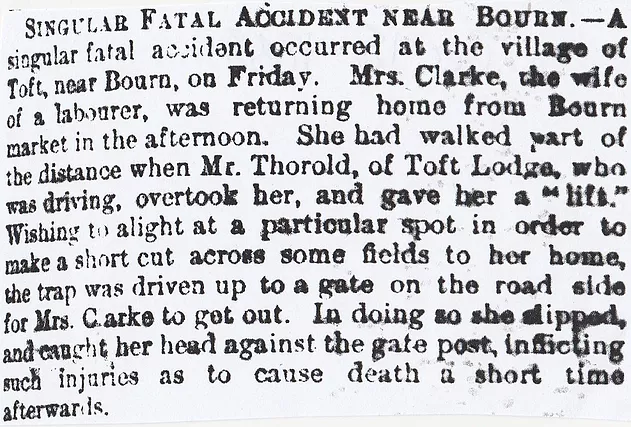
127/ Waggon & Horses Fire Death, Langtoft, October 1888 (Waggon & Horses is next to the church on Bourne Road crossroads)
A fire at the Waggon & Horses pub at Langtoft near Bourne resulted in a fatality. Charles Woodward was killed by the chimney and a wall collapsing during a fire at the public-house. All the occupants were ushered outside and a few got through bedroom windows. While the fire was at its peak, Woodward was stood gawking at the flames when a wall and chimney fell down on him. He was extricated but was badly mangled and burned, with nearly every bone in his body broken. Another man Samuel Deaken was nearby and has life-threatening injuries as well. He was warned by police to stand back, but he ignored them.
128/ Boultham Railway Fatality, March 1882
Seventeen-year-old William Spalding was working on the construction of a new line between Lincoln and Spalding and had been doing the job for eighteen months. He was in Boultham uncoupling a couple of waggons, but he did it while it was moving. This was to be his undoing, as he slipped off and under the waggons, which weighed a couple of tons apiece and was run over. When they got him to County Hospital he died within the hour and it was discovered that his abdominal cavity had about four pints of blood in it, plus other severe internal injuries.
129/ Rippingale Machinery Death, September 1880
Frederick Foyster, alias Swan, was working in Mr Worman’s field reaping barley, where they used one of those new-fangled reaping machines. Foyster was driving it and sat in the seat between the horse and the rakes. All of a sudden one of the horses reared up, scared by something and Foyster was kicked off the seat by the horse and fell off in front of the knives of the machine. He had a massive cut on his thigh, so they rushed him to the local doctor. He, in turn, told them to take him to the Infirmary at Stamford, which is about fifteen miles away and this took four hours. He died from the loss of blood.
130/ Blue Anchor Pub Fatality, High Street, Lincoln, June 1866 (Still there at 133, High Street)
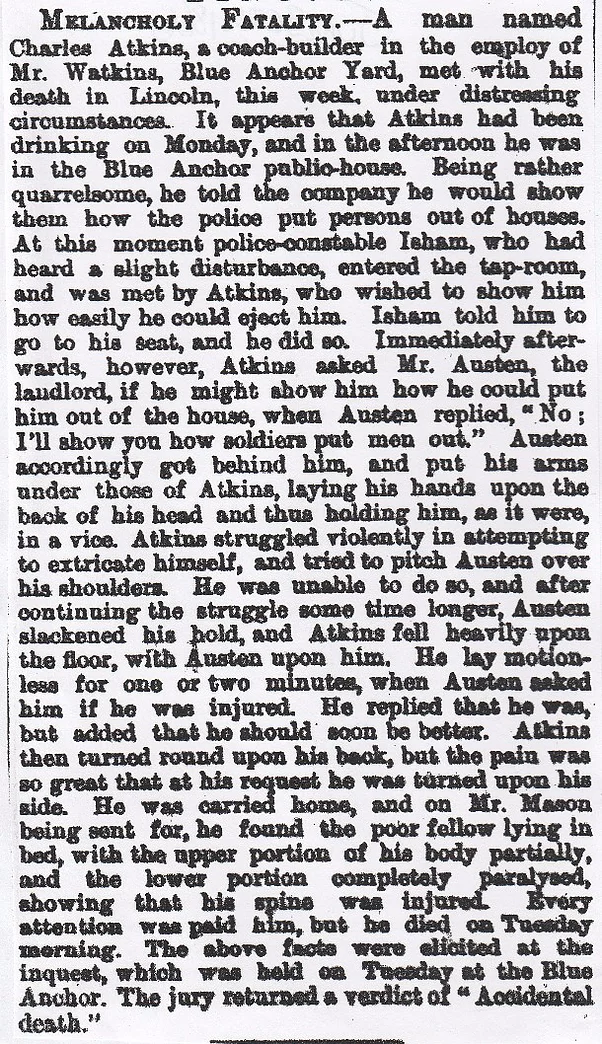
131/ Metheringham Child Murder, July 1868
Lucy Buxton was charged with the wilful murder of her five-month-old son, by giving him Battle’s Vermin Killer. It was circumstantial evidence that pointed to the culprit being Lucy but the jury thought that was enough and sentenced her to death. She fainted on hearing her fate. The twenty-two-year-old domestic servant was later reprieved and the sentence was commuted into transportation for life, probably Australia.
132/ Helpringham, April 1894 (Death of a Footballer)
A young man named Hannarth, the manager of a sewing machine establishment at Sleaford named Singer and Co, was fatally injured whilst playing in a football match. He was playing for Sleaford Town as the goalkeeper and while defending the goal, he was charged with such force that he died a few seconds later. It was a collision between Hannath and a Helpringham forward named Garton, which caused his death. The autopsy revealed that he died due a rupture of the heart. He had used an alias to play football because his wife didn’t want him to. He left three children and a widow, who in the end, was right to be worried.
133/ North Hykeham Murder, November 1817 (Did they find the murderer?)
The body of fifteen-year-old servant John Perkins, was found in a roadside ditch on the road from Lincoln to Newark, in the village of North Hykeham. He sustained severe head injuries with a fracture of the left temple, plus other bruises which were caused by a blunt instrument, probably a stick. The murderer left a small clue behind, a tobacco box which is now in the hands of the police.
134/ Washingborough Murder, March 1870
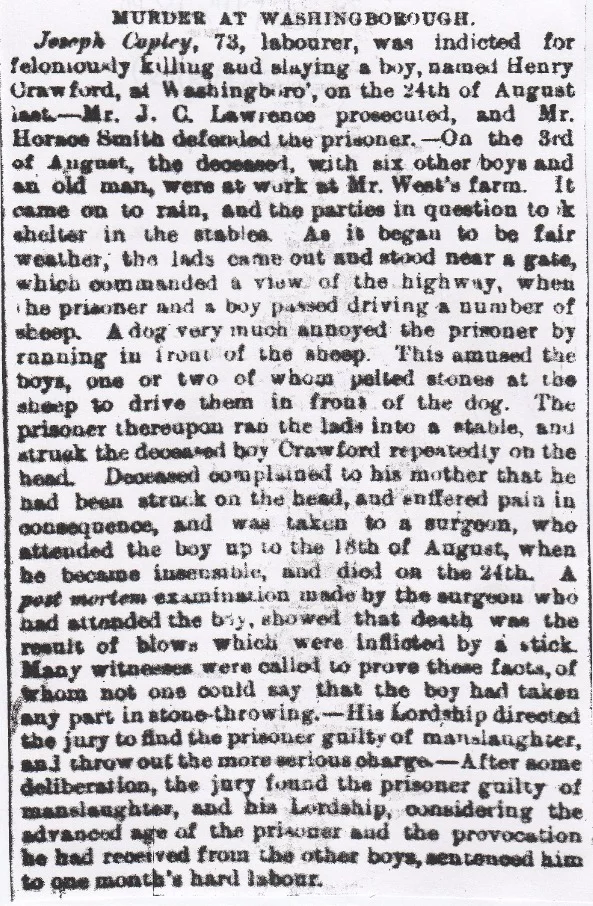
135/ Grantham Mystery, October 1862
This is a weird little mystery that occurred in Grantham. A lass by the name of Mary Hodson was up in court on a charge of stealing some items from her master, Charles Wand of Vine Street. She pleaded “Not Guilty”, but she was committed for trial and put in a police cell. A couple of hours later when she was being checked on by the warder, she was laid on the floor, dying and writhing in pain. As it turns out, her father had brought her something to eat, a pork pie in fact and she explained to the warder that it was that pie which was killing her. Doctors were summoned, but she died in her mother’s arms. As Grantham was not as technically advanced as other places, the testing for poisons in her stomach contents was sent down to London. (Was it her father that poisoned her?)
136/ Grantham Railway Station Fatality, March 1887
Just before eleven p.m. Saturday, Eli Addlesee, an engine driver was killed at Grantham Station. He had just brought in a goods train from Sleaford and arrived at the shunting yard, he got out and told the fireman that he was off to talk to the guard. On his way, around thirty-five waggons came along and he was struck on the back of his head. He was knocked out cold and killed on the spot. He leaves a widow and two children.
137/ Lincoln/Washingborough December 1882 (Railway Fatality)
John Henry Pacy aged twenty-five, was run over and killed on the railway line between Lincoln and Washingborough. He had been with his father the previous day drawing £16 out of the bank and then he told his father he wasn’t feeling very well, so the father said he could spend a couple of weeks with him at Eagle. The engine driver, Richard Mitchison, said he left Washingborough at 6-19 a.m., and when about half a mile from Lincoln he felt the engine go over something. He checked and it turned out it was the body of Pacy which was badly mangled.
138/ Washingborough (Fatal Skating Accident) January 1879
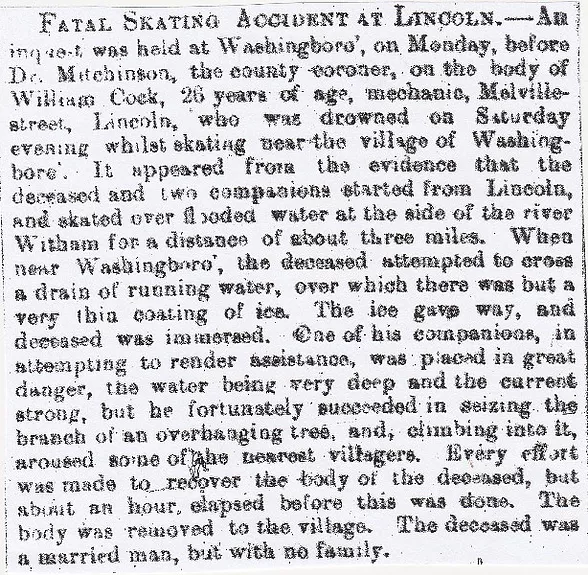
139/ Greatford (Four Killed) October 1892
A granary at Greatford collapsed, causing the deaths of three men and one woman. Six people were in a barn at Messrs Dean, farmers, of Dowsby and Greatford, working away. They were Ambrose Cook aged forty; John Cook aged nineteen; Charles Charity aged forty-six and George Preston and Frederick Holmes. The woman, twenty-one-year-old Kate Arden was employed to hold sacks open, while up above them in the granary, a lad named Thomas Curtis would send the corn down a shoot. Around three p.m. the beam holding up the granary collapsed, sending the place into chaos. Ambrose Cook, John Cook and Charles Charity and Kate Arden, were buried under tons of corn and debris. They were extracted within the hour, but all were dead, probably having suffocated to death. The weight of the barley in the granary was way too much, causing the beam to break and four people to have been killed.
140/ School of Art Fatality, Monks Road, Lincoln, November 1885
The landlord of the Wheatsheaf Inn on Broadgate, Stephen Woodhouse aged fifty-five, was working in the School of Arts at Monks Road doing some plastering work. He was putting some laths on the ceiling in one of the upper rooms when the plank he was standing on snapped in two and he was precipitated fifteen feet, at first hitting a joist with his back then onto the rock-hard floor. He died about a week later, while in hospital.
141/ Fulbeck Railway Suicide, January 1874
This little village between Sleaford and Newark saw a teenager kill himself on the railway tracks. The lad was fifteen-year-old Thomas Sharpe, with no parents, he was brought up by a Mr Scott in Fulbeck. One day he went to the village shop and nicked a popgun. When Mr Scott found out he made him take it back, but the shop owner, Mr Lewarton, said he would tell the police. On top of this, Reverend Peacock told him off for being lazy in his work. One afternoon, he saw Richard Parker, a younger boy than himself and asked him if he wanted to see him be run over by a train. Parker was up for the offer and probably thought he was kidding, but when they got to the line, the three p.m. Grantham to Lincoln train came into view. Sure enough, Sharpe popped his head on the train-track and let the engine and carriages go over his head. Parker ran to the village in a state of shock and the train driver of the one after saw the mutilated remains and reported it to the authorities.
142/ No 1 High Street suicide, Grantham, September 1888
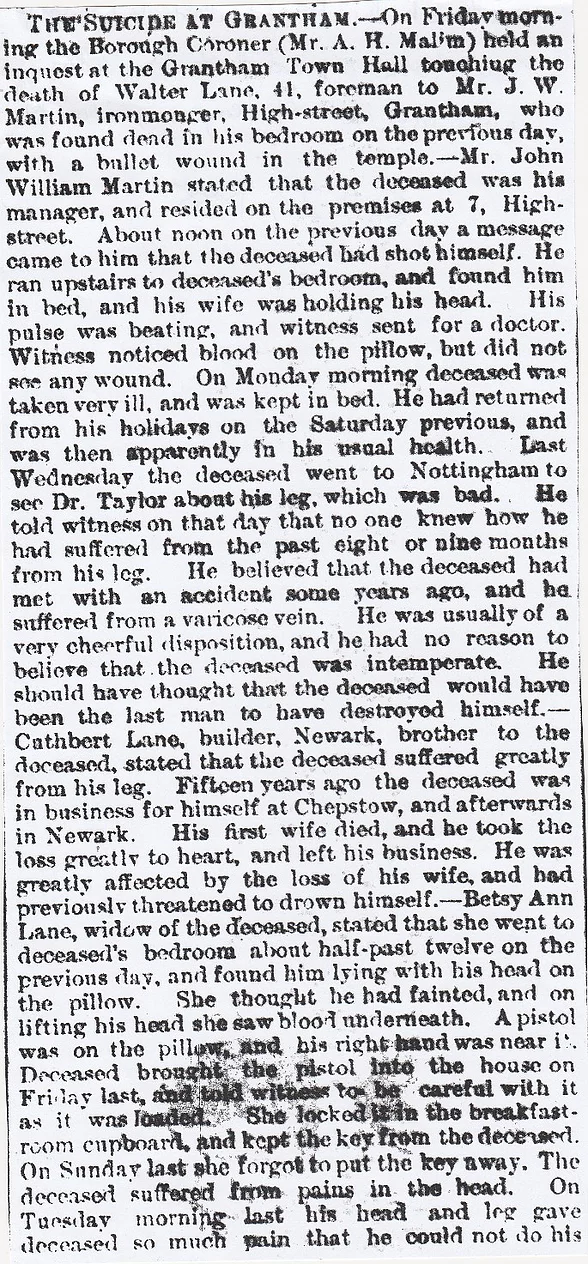
work and threatened to destroy himself. A jury returned a verdict of “Suicide whilst in a state of temporary insanity”
143/ Metheringham Suicide, October 1887
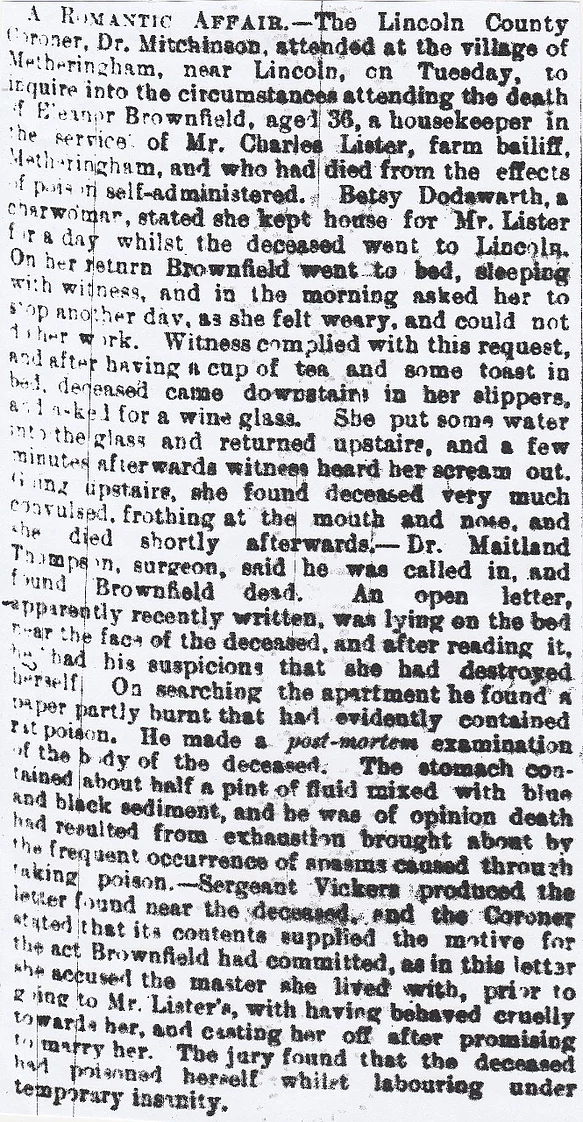
144/ Cornhill Suicide, Lincoln, January 1885
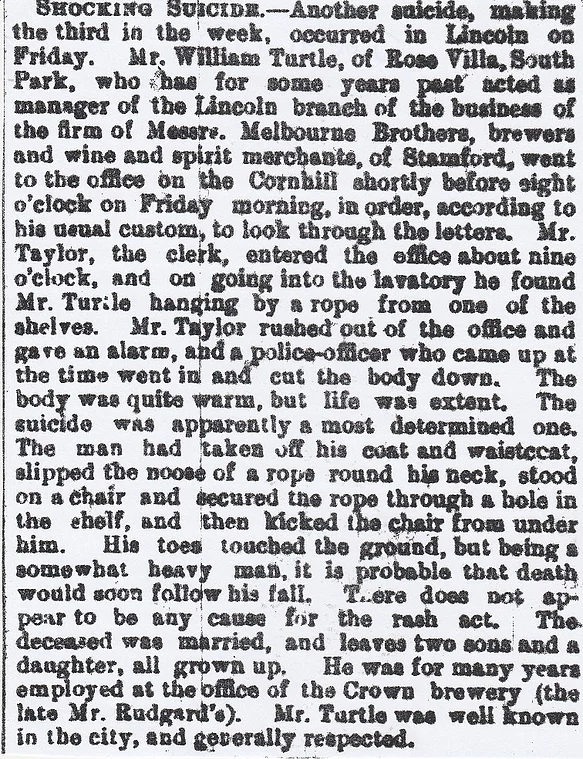
145/ Billinghay Murder, August 1866
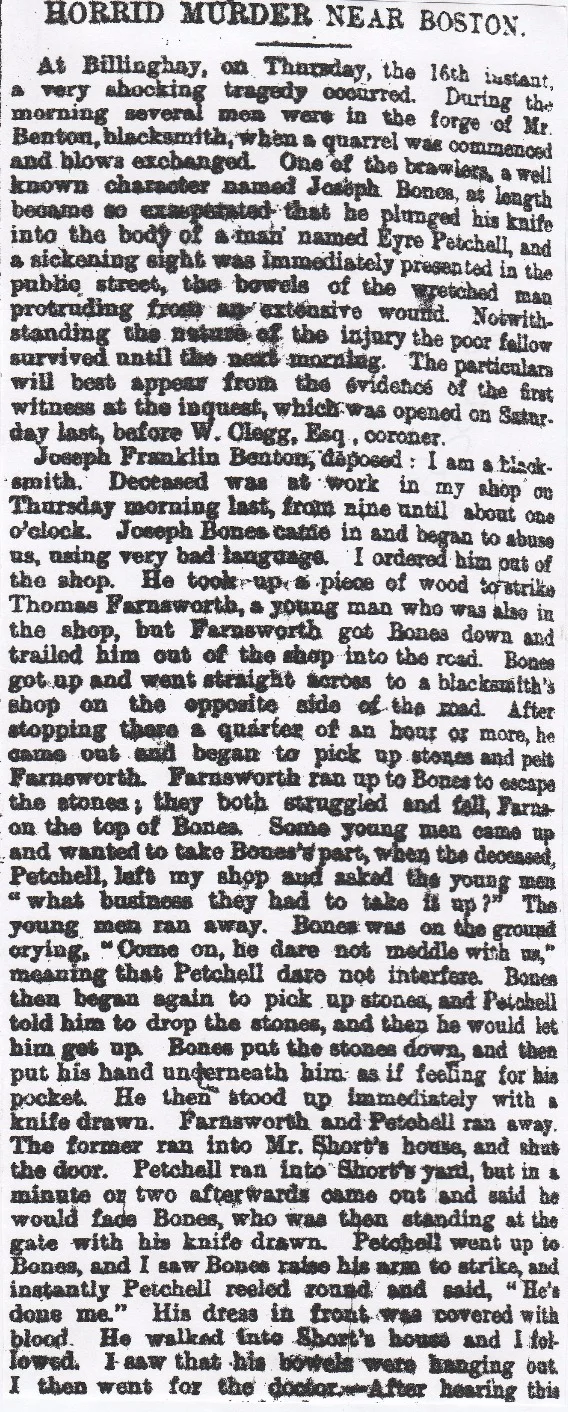
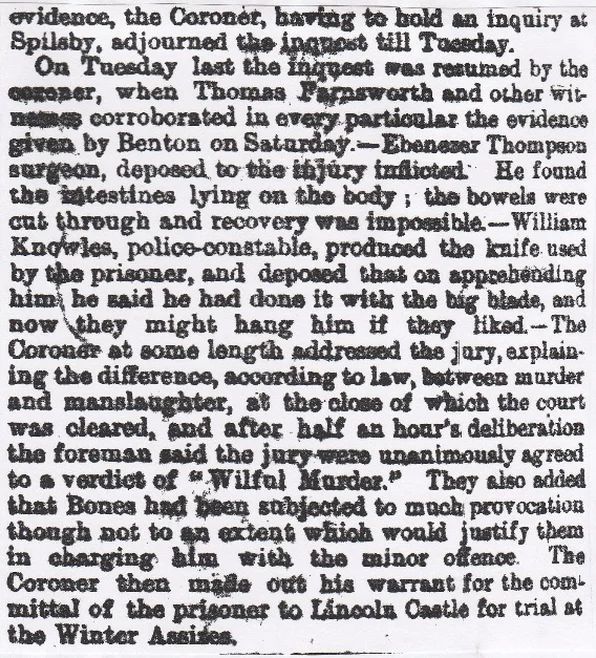
Billinghay Murder, December 8th, 1866
Joseph Bones, charged with the wilful murder of Eyre Petchell at Billinghay on the 16th of August last- Evidence being given that prisoner was of unsound mind, he was ordered to be detained during Her Majesty’s pleasure.
146/ River Witham Suicide, Lincoln May 1879
A boat-woman named Ward was sitting in a canal boat on the Witham waiting for her husband to come home when she heard a fairly loud splash coming from just down the river. She immediately thought it was hubby, who was probably drunk and had fallen in while inebriated. A few people had gathered around and steps were taken to drag the river. In the meantime, her husband returned. During the search, somebody had gone to the police station and filed a missing person report on a 19-year-old domestic servant named Elizabeth Cross, who had disappeared. She worked at the Albion Hotel (St Mays Street, across the road from train station, Barbican Hotel) and a letter had been found there addressed to the cook, stating that was going to drown herself.
It was the usual story, deserted by her lover, can’t go on without him, etc etc. Finally her corpse was found the next morning floating below the locks and it was taken to the Druids’ Arms Inn.
147/ Stamford Manslaughter, February 1890
Thirty-year-old foundryman, John Walker, was accused of causing the death of 65-year-old Joseph Ireland at Stamford. Ireland was living with Walker’s mother and the son, when one evening while drunk he struck his mother. Ireland flew into a rage saying that he wouldn’t let a thing like that happen in his house. He tried to throw Walker out and this led to a scuffle and punches were thrown. He managed to pin down the old man and knelt on the chest. Several passers-by managed to wrangle them apart and when the old fella tried to get up, he slumped straight back down to the ground and was dead within a minute. (What happened to Walker? Presumably, he was charged with manslaughter?)
148/ Stamp End Works, Lincoln March 1865 (Drowning)
William Parks aged twenty-eight, worked at the Stamp End Iron Works and was found one evening face down in the water, at the Lock near the Stamp End Works. He had been at the Lock Tavern enjoying a few jars and decided to go home over the Lock Bridge, which is hazardous when you’re ratted and its pitch black. About halfway along the bridge was a set of stone steps and he seems to have fallen down these and rolled into the water. Before anybody could reach him, he was drowned. Ironically, a hand-rail had put up on the bridge that very day, to prevent people from slipping in.
149/ River Witham (Another Suicide!) May 1887
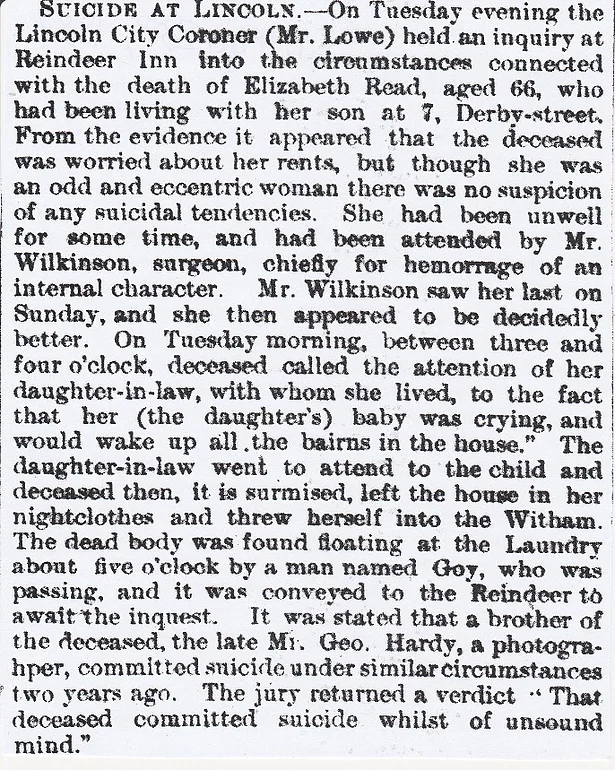
150/ Boultham Murder (Lincoln) May 22nd, 1903
Leonard Patchett and his older wife, Sarah Ann, had a strained relationship right from the beginning of marriage. He liked a tipple and he would get violent with her on a regular basis. She got a job in Boultham and was a housekeeper to a man in Spencer Street. Patchett hunted his wife down to her new address and pleaded with her to come back home, which she didn’t totally dismiss, but told him he had to calm the drinking down. They parted company and Patchett went off to see his sister in Gainsborough for a few days and to try and work out what to do next. He kept on imagining that the gentleman she was working for, a Mr King, and his missus were having a secret fling. They met up again and went for a walk on Boultham Lane and again he asked her to return home, but she must have said “No” and he must have lost his temper and he strangled her. The lifeless corpse of Sarah Ann was discovered in a field near Boultham Lane three days later.
Patchett was found guilty of her murder and executed by William Billington at Lincoln Prison on July 6th,1903
151/ Grantham Train Mystery (Stoke’s Tunnel) September 1886
On Sunday evening the body of a man unknown was frightfully smashed in Stoke’s Tunnel near Ponton, Grantham. The guard of the train which arrives at Grantham shortly after eight o’clock from London, heard the sound of a crash when passing through the tunnel and on arriving at Grantham found a third class compartment door open and in the carriage, placed on the rack, a man’s hat and umbrella. He told the authorities at Grantham Station who at once checked the tunnel and found the mutilated body of a man. It is supposed that he committed suicide by leaping off the train and had taken great precaution to conceal his identity, as the name was torn off the collar and his pocket-book was also torn up. He is approximately 35-40 years of age, five feet six inches tall, dark brown hair and moustache. He had around £4 in money and another ticket dated the 19th September, from London to York.
The body is thought to be that the Plymouth swindler, Mr Curteis, who is said to have absconded after misappropriating a large sum of money from certain funds.
152/ Grantham Train Mystery, October 2nd,1886
The body of Mr Algernon Swaine Kingsford was on Saturday removed from Grantham to London for interment. Mr Parish, chief of the G.N.R. Company’s Police, Kings Cross, came to Grantham by the 11-28 on Saturday morning at the request of the relatives, to superintend the removal. It appears that Mr Kingsford, sen. holds the position of magistrates clerk at Canterbury and that the deceased was a stockbroker carrying on business at 2, Angel Court, Throgmorton Street, London.E.C. The cause assigned for the rash act was a love affair.
153/ Hungate, Lincoln, (Invalid Burnt to Death) April 1887
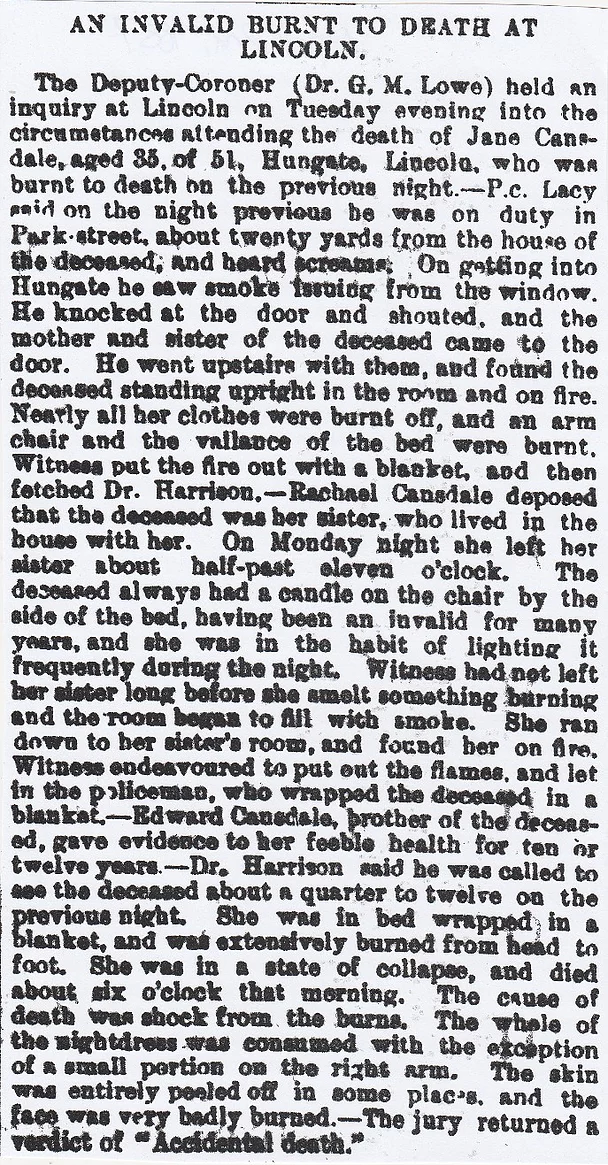
154/ No.58 High Street Suicide, Grantham, February 1885
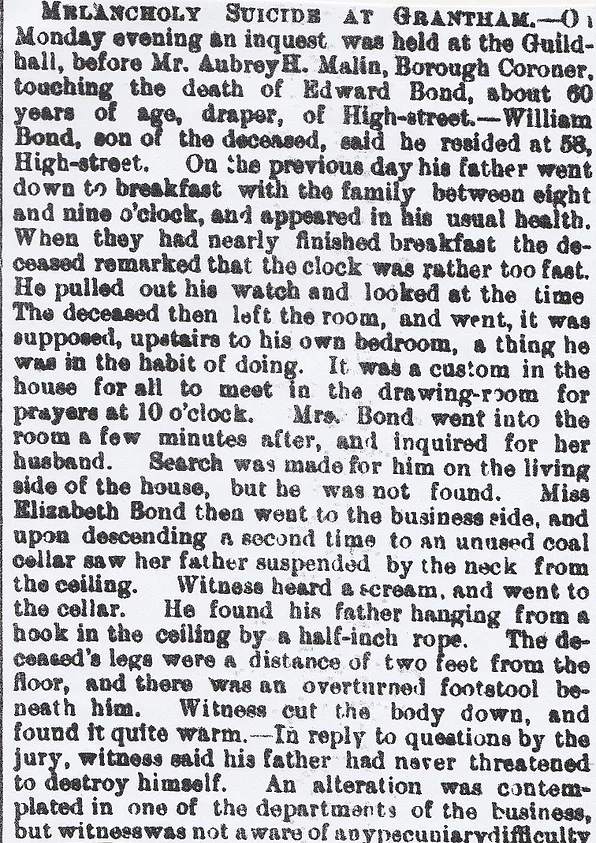
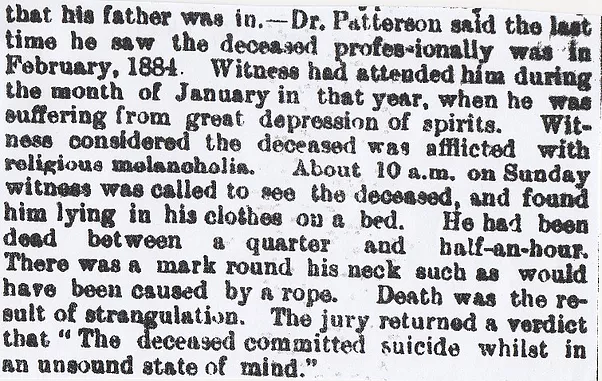
155/ Brayford Pool, Lincoln, (Unknown Corpse) November 1886
Elizabeth Ogden, the wife of John Ogden an Inland Revenue Officer from Derby, was found drowned in Brayford. Her husband had separated from her in 1874, due to her constant drinking and she went to live in Potterhanworth. When she received £2 from her trustee, she headed straight for the pubs of Lincoln and started on the brandy. However, when she left the pub, she was sober and she was seen walking on the Brayford side when she fell in accidentally. The water was only six feet where she went in and a boatman got a hook and got her out within a few minutes. He didn’t bother with resuscitation for some reason and got a policeman instead, it was this inaction that caused her death. Elizabeth was pronounced dead shortly after and found to have £10 and a gold watch and chain on her. So it was just a case of accidentally drowned then! Nope! Turns out it was a case of mistaken identity and that Mrs Ogden was in fact in Nottingham, but the two aunts of Mrs Ogden had identified the corpse as that of their niece. Mr Ogden stayed in Lincoln and had his wife interred, then going back to Nottingham to have a word with her trustee, Mr Cleveland, to sort out matters. No sooner had he stepped out of his office, then his wife Mrs Ogden turned up to get her allowance. Mr Cleveland then told authorities in Lincoln, that Mrs Ogden was alive and well.
The only identity clue that police have to the body is the name of a milliner in Retford, on a tag inside her bonnet and a watch-key with the name “J.Saltby, Alford” on it.
156/ Deeping St James Wife Murder, December 1888
Ellen Bennett, the wife of a cottager aged fifty, was the victim of wife murder in Deeping St James. A neighbour, Mrs Perrin, had popped in and asked Bennett how his wife was, to which he gave a rather evasive answer. She was suspicious and went upstairs to check on her, where she found the body of Ellen lying on the bed fully clothed, drenched in blood. Mrs Perrin ran to the husband, shouting that his wife had been killed, to which he replied “Serve her right! I gave her more this time than last time. She won’t want to go to Stamford anymore in the cart”. Perrin went the police and when they called on him he was calmly digging his garden. He told them that he had tried to strangle her, but in the end, he kicked her to death. It is believed that he became sick of her drinking habits. She went to Stamford a month ago to sell some produce but stayed and got drunk in the pubs and had to be brought back home. Again this week, she had done exactly the same and when she got home they both started on each other and he lost it and began to attack her. The husband, Thomas Bennett was found guilty of manslaughter, due to the fact that she had a weak heart and his ill-treatment, brought on syncope (loss of consciousness from fall in blood pressure) causing her death.
157/ Lincoln/Washingborough Child Murder, September 1879
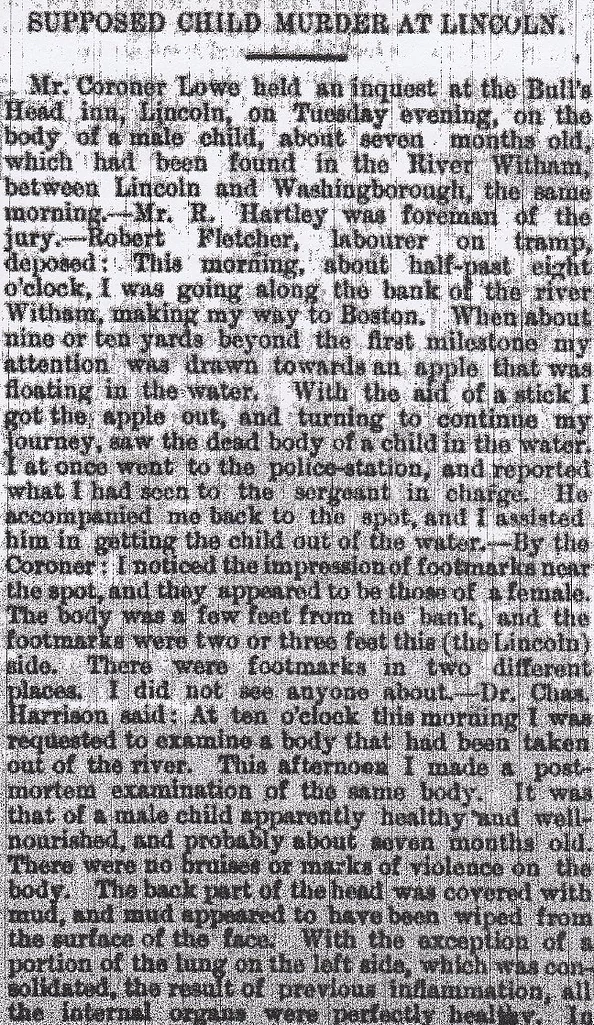
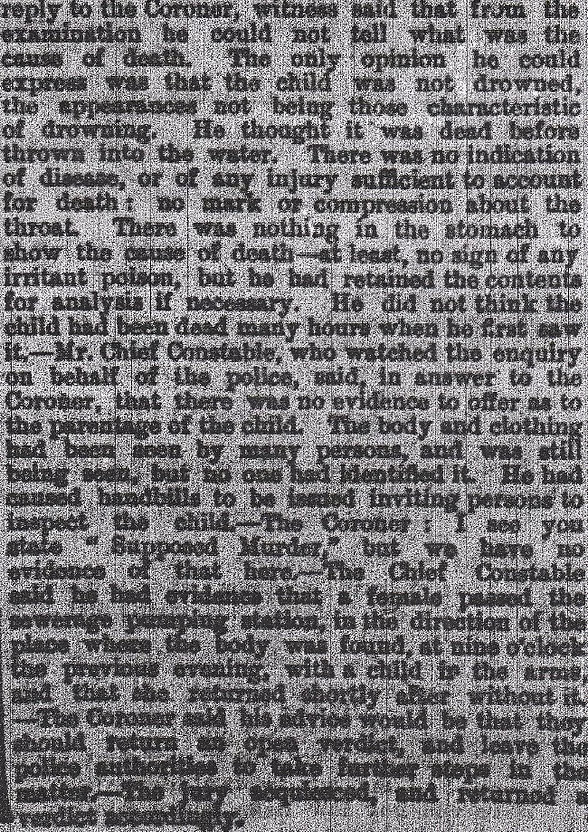
158/ Spread Eagle Tap Fatality, Lincoln, June 1883
An inquest into the death of 25-year-old Thomas Heywood who lived with his Mum at No.1, East Court, Christ’s Hospital Terrace, Lincoln, and died under the strangest of circumstances. He left home at seven a.m., and at three p.m. seemed to be in rude health. He was next seen at 10-30 that evening in the bar of Spread Eagle tap, where he walked through to the tap room which was unlit, then at eleven p.m, he was found lying on the floor unconscious. The landlord thought he was drunk and had laid him down there. A woman named Wadsworth stayed with him as she thought he looked poorly and then told Inspector Briggs, who then went for help. He tried a little brandy to revive him, but he couldn’t swallow. Then the doctor arrived and gave orders that he wasn’t to be moved. He lingered on through the night and was dead as a dodo the next morning. His temple had a swelling on it and he had a graze on his cheek, with a slight blackening of his right eyelid. He couldn’t move his limbs on the left side. (Stroke?) The post-mortem revealed a huge clot between the skull and covering of the brain and a fracture of the skull itself. It was deemed “Accidental Death”, with the coroner suggesting the injuries were more likely from a fall than being hit by somebody.
159/ Stamford Murder/Manslaughter, November 1878
Martin Cummings aged nineteen was charged with the murder of Thomas Cecil Chaplin Toon at Stamford on the 5th of August. Some people from the outlying villages of Stamford had gathered to watch some athletic sports and 47-year-old Toon was on the bridge at Stamford with a speaker calling out “Ladies and Gentlemen, something you have never seen before”, with the sole purpose of calling to attention to somebody diving off the bridge and into the water. Cummings arrived and demanded “Have you got the one shilling and ninepence you owe me?”, then say “It’ll be your turn next. It should be you go over and not the other”. He grabbed hold of him and threw him over the parapet, then he legged it. He was arrested by police a little while later and Toon was meanwhile pulled out of the river. He said he ran off because he didn’t want the crowd of people to mob him. Toon fell twenty feet, into seven feet of water. The case was treated as one of manslaughter not murder, with Cummings meaning to hold him over the edge and scare him, not to throw him in and kill him. He was sentenced to penal servitude for the rest of his natural life.
160/ Langtoft Child Murder, November 1879
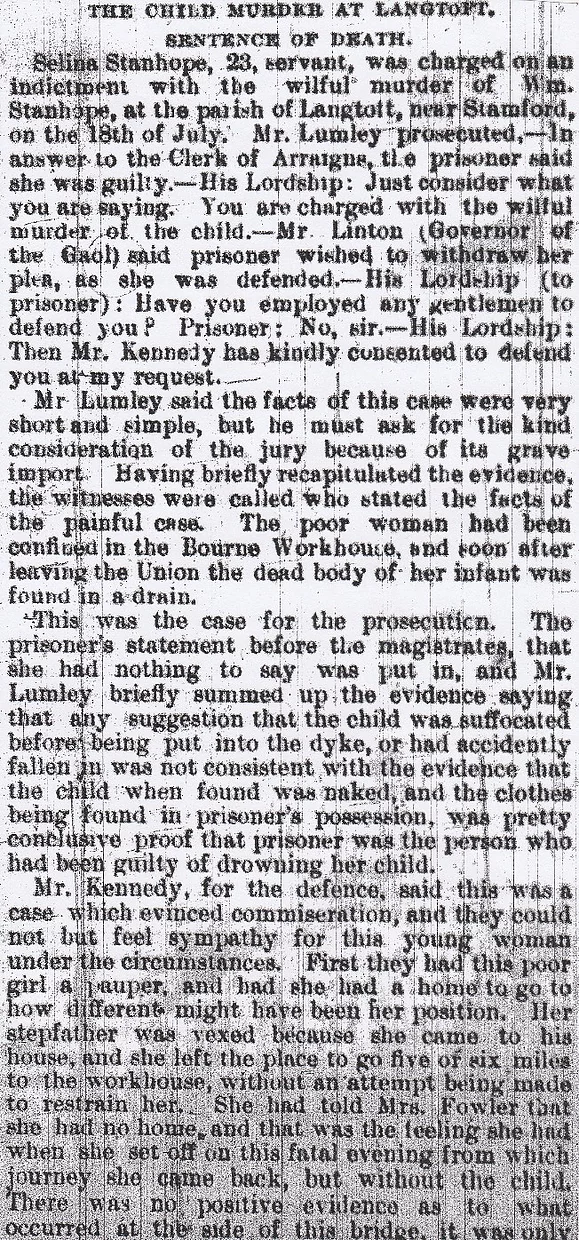
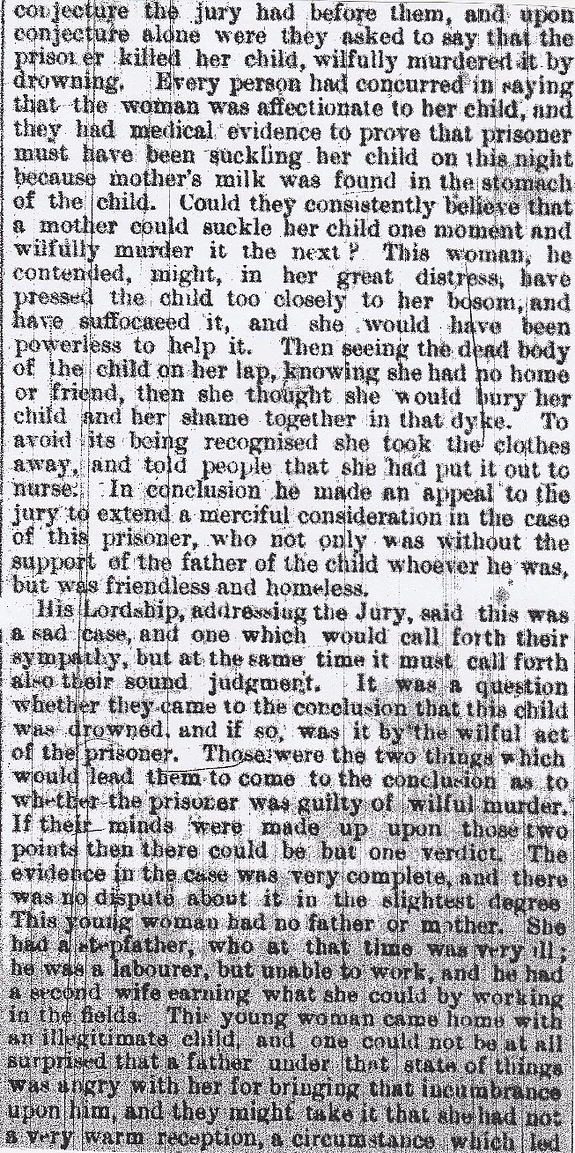
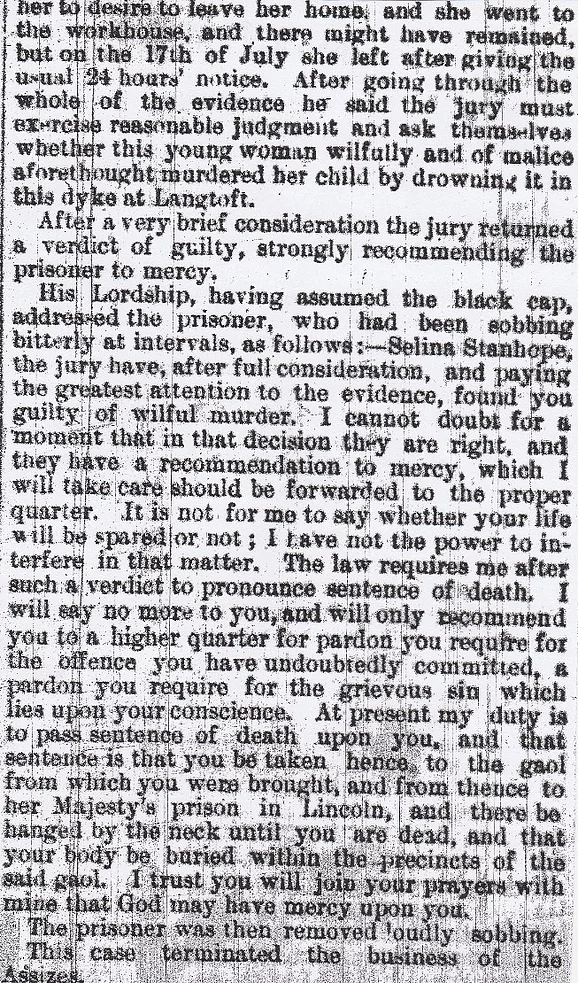
Langtoft Child Murder (Reprieve) November 22nd, 1879
